- Show Spoilers
- Night Vision
- Sticky Header
- Highlight Links

Follow TV Tropes
http://tvtropes.org/pmwiki/pmwiki.php/Recap/StarTrekVoyagerS2E19Lifesigns

Recap / Star Trek Voyager S 2 E 19 "Lifesigns"
Edit locked.
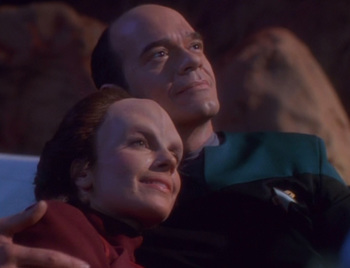
This episode provides examples of:
- Anachronism Stew : Tom Paris lends the Doctor his holodeck program involving a '57 Chevy overlooking a city on Mars. That's right, it's a Make-Out Point IN SPACE!
- Auto Erotica : The Doctor and Danara share a kiss (presumably a First Kiss for both of them) on their 'date' on the holodeck in the car.
- Badass Boast : The Doctor can't help showing off to a fellow doctor. Danara: Your technique is very impressive. EMH: It's all part of my programming. For example, this exact procedure was developed by Doctor Leonard McCoy in the year 2253. I'm equipped with the collective medical knowledge of more than 3000 cultures. Additionally, as you see here, my imaging system allows me to perform, and in many cases improve upon, the most delicate tactile manoeuvres required by a dizzying array of surgical procedures.
- Birds of a Feather : Danara and the Doctor are both in the medical profession and socially isolated.
- To the events of "Faces", when the Doctor has to convince a furious B'Elanna to donate some of her brain tissue. Danara mentions having read the report on what she was forced to undergo.
- The Doctor uses a technique developed by Dr McCoy from Star Trek: The Original Series .
- Captain's Log : The Doctor starts his personal log.
- Cringe Comedy : Acting on Kes' advice, The Doctor straight up asking Danara, in the middle of a surgical procedure , mind you, if she shares his romantic feelings. Kes winces.
- Cute Monster Girl : Susan Diol's makeup as Phage-infected Denara is noticeably less grotesque than the standard Vidiian makeup & prosthetics, with the most serious disfigurements limited to the left side of her face and head.
- Damned by Faint Praise : After being rejected by Danara, the Doctor goes to Paris' Marseille tavern to seek his advice: EMH: Mr. Paris, I assume that you have had a great deal of experience being rejected by women . Paris: Oh, thanks a lot, Doc.
- Dance of Romance : Despite the Doctor protesting that he's not programmed for romance , the episode ends with him dancing with Phage-infected Danara.
- Did They or Didn't They? : Although their onscreen relationship appears to be mostly platonic (though there's another two weeks after the episode ends that we don't see) in "Message in a Bottle" the Doctor boasts of having sex, but doesn't say with who. This episode and "Real Life" (when the Doctor creates a holographic family) are the only candidates. Certainly Danara Pel would be well motivated; she's had the Phage since she was a child, so this may be her first and only chance to have sex before she dies .
- Does This Remind You of Anything? : Danara basically attempts to euthanize herself by sabotaging the Doctor's treatment so that she won't have to 'go back' to her real body. Her arguments for doing so are presented more sympathetically than those used in "Emanations" .
- Dr. Jerk : It's unconscious on the part of the Doctor, but his bedside manner still needs some work.
- Even Evil Has Standards : Jonas may have no problems with feeding information to the Kazon, but he's not so thrilled about sabotaging Voyager .
- Face Palm : Kes basically does this when the Doctor bluntly admits his feelings to Danara.
- Florence Nightingale Effect : The Doctor and Danara fall for each other while the Doctor is trying to treat her disease.
- Flowers of Romance : Apparently on the advice of Tom Paris, the Doctor presents Danara with a bunch of flowers on their date, but immediately follows it up with a gift-wrapped box (presumably Chocolate of Romance ) and a stuffed toy . Fortunately she's just amused, being unfamiliar with human courting rituals.
- For the next episode "Investigations", as Jonas finally makes contact with Seska, who wants him to sabotage the ship. Tom Paris decks Chakotay, leading to his decision to leave Voyager voluntarily rather than face court martial.
- Tom Paris jokes that he was delivering Ensign Wildman's baby, which will happen for real in "Deadlock".
- Holding Hands : More significant for Danara than the Doctor, as physical contact with a Phage victim is frowned on in Vidiian society.
- I Can't Dance : But at the end of the episode, they do (the Doctor states that he added the necessary subroutines to his program).
- Married to the Job : When Danara asks the Doctor about his life, all he has to boast about is a list of surgical procedures he has performed — there is nothing personal about his program and nothing that he does for pleasure. This changes a good deal in the future.
- The Mirror Shows Your True Self : Inverted.
- Mythology Gag : The Doctor cites Leonard McCoy as one of his many medical reference sources. Presumably that's where he picked up his habit of saying " I'm a Doctor, Not a Placeholder ".
- The Nameless : Danara feels she has to call the Doctor something, so she names him after her Cool Uncle Schmullus.
- No Social Skills : Kes advises the Doctor to tell Danara of his feelings. So he casually drops the bombshell in the middle of an operation .
- Not a Date : Are you sure, Doctor?
- Open Heart Dentistry : Averted for once. Danara specifies that she's a hematologist.
- Out Of The Shadows Reveal : Danara walking into Sandrine's after she's been put back in her diseased body. The Doctor isn't fazed in the least.
- Prefers the True Form : To prove that he does not love Danara for her beauty had she not been ravaged by The Phage, the Doctor shares a dance and a tender-loving kiss with her in her real, deformed and decaying body.
- Series Continuity Error : Danara says the Phage has been infecting her people for hundreds of years, whereas in "The Phage" it was stated to be a couple of millennia.
- Shipper on Deck : Kes is having a grand old time watching the Doctor experience first love, and Tom Paris offers his own support.
- Shout-Out : The Doctor turns on the radio in the holographic car, which plays My Prayer by The Platters.
- Showing Off the New Body : A non-sexual version.
- Suddenly Shouting : In the middle of her conversation with Jonas, Seska cranks up the volume and snaps at him before returning to her normal calm and quiet voice. Apparently she's figuring out that cozying up to a leader isn't all its cracked up to be in a patriarchal society.
- Tears of Joy : Danara's first reaction to her whole, unblemished reflection is to sob; she never expected to see a reflection of a healthy face again.
- That Came Out Wrong : The Doctor goes to Tom Paris for advice after Danara apparently rejects him. EMH: Mr, Paris, I assume you have a great deal of experience being rejected by women .
- Two-Faced : So Danara Pel can be a Cute Monster Girl as well as The Grotesque .
- What Is This Thing You Call "Love"? : Kes finds the Doctor running a diagnostic on his systems, trying to find out what's wrong with him.
- What Measure Is a Non-Cute? : The show depicts a healthy Vidiian for the first time, albeit through a holographic recreation.
- Worldbuilding : A more sympathetic look at the Vidiians.
- Star Trek Voyager S 2 E 18 "Death Wish"
- Recap/Star Trek: Voyager
- Star Trek Voyager S 2 E 20 "Investigations"
Important Links
- Action Adventure
- Commercials
- Crime & Punishment
- Professional Wrestling
- Speculative Fiction
- Sports Story
- Animation (Western)
- Music And Sound Effects
- Print Media
- Sequential Art
- Tabletop Games
- Applied Phlebotinum
- Characterization
- Characters As Device
- Narrative Devices
- British Telly
- The Contributors
- Creator Speak
- Derivative Works
- Laws And Formulas
- Show Business
- Split Personality
- Truth And Lies
- Truth In Television
- Fate And Prophecy
- Edit Reasons
- Isolated Pages
- Images List
- Recent Videos
- Crowner Activity
- Un-typed Pages
- Recent Page Type Changes
- Trope Entry
- Character Sheet
- Playing With
- Creating New Redirects
- Cross Wicking
- Tips for Editing
- Text Formatting Rules
- Handling Spoilers
- Administrivia
- Trope Repair Shop
- Image Pickin'
Advertisement:
- Buy the Book…
- Reviews Hub

the m0vie blog

Following Us
- Adding Our RSS Feed to Your Gmail
- Following our Feed in Internet Explorer
- Millennium (Reviews)
- Star Trek: Deep Space Nine (Reviews)
- Star Trek: Enterprise (Reviews)
- Star Trek: The Next Generation (Reviews)
- Star Trek: The Original Series (Reviews)
- Star Trek: Voyager (Reviews)
- The X-Files (Reviews)
- X-Files Fandom Poll Form
Check out the Archives

Awards & Nominations

Star Trek: Voyager – Lifesigns (Review)
This February and March, we’re taking a look at the 1995 to 1996 season of Star Trek , including Star Trek: Deep Space Nine and Star Trek: Voyager . Check back daily Tuesday through Friday for the latest review.
Lifesigns is a fascinating piece of television.
In hindsight, it seems a shame that the production team decided to focus on the Kazon during the first two seasons of Star Trek: Voyager . The Kazon are perhaps the most unfortunate and misguided recurring alien species to appear across the entire Star Trek franchise, never quite afforded the redemption that turned the Klingons and Ferengi from two-dimensional caricatures into fully-formed and well-realised species. The Kazon were a misguided creation in Caretaker ; they remained so in Basics, Part II . Shattered offers no redemption.
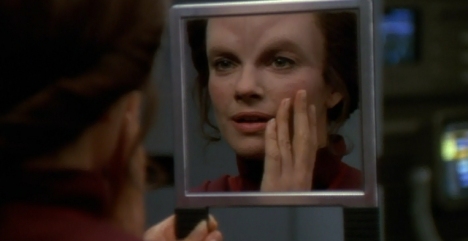
The face of the frenemy…
In contrast, the Vidiians are much more interesting. To be fair, it is possible that the Vidiians are so interesting precisely because they are underused; their appearances tend to be motivated by the demands of individual episodes rather than by some grand desire to create an iconic Star Trek species. At the same time, it is perhaps too much to suggest that the Vidiians are fully-formed or multi-faceted; the show never offers them the same opportunity for development afforded to species like the Kazon or the Borg or the Hirogen.
Despite all this, Lifesigns demonstrates the Vidiians can be used in an interesting and creative way. Even as the episode dedicates considerable space to demonstrating that Kazon are a much less interesting new species.
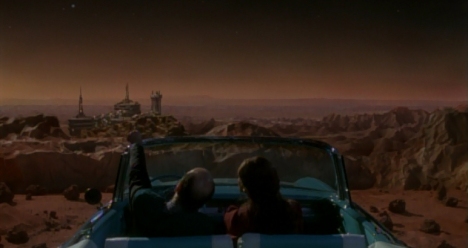
Starin’ at the stars…
The Vidiians are an alien species dedicated to body horror. It is no surprise that Brannon Braga was responsible for introducing the species in Phage ; even the title of the episode makes it clear that they are an alien species defined primarily by the affliction that has turned them figuratively (and possibly literally) into monsters. In fact, Lifesigns is the first and only time that we get to see what a “basic” Vidiian might look like, the body unravaged by disease and undistorted by desperate attempts to keep the patient alive.
The Vidiians undoubtedly fit with the fifties b-movie aesthetic of the first few seasons of Voyager . There is something quite unsettling about a species composed primarily of disfigured hermits waiting to prey on unsuspecting travelers, harvesting their organs so as to extend their own life. Vidiian society is never explored or defined in the same way as the Klingon Empire or the Cardassian Union; Voyager couldn’t care less about the politics of these dangerous deformed predators.
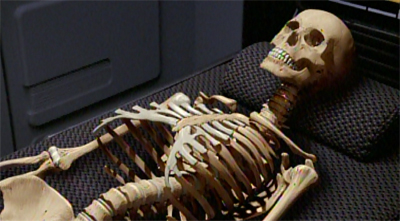
No bones about it…
However, the Vidiians spreak to more than just classic fifties horror movies. They are not simply the latest iteration of atomic mutants or grotesque space invaders. They are very much a product of the body horror renaissance of the eighties. As Stacey Abbott contends in The Battlefield for the Soul , this was rooted in the AIDS crisis:
Philip Brophy argues that the contemporary horror film of the 1970s and 80s ‘play[ed] not so much on the broad fear of Death, but more precisely on the fear of one’s own body, of how one controls and relates to it.’ I would argue that, more precisely, these films captured the horror of the loss of control of one’s body, embodying a range of anxieties surrounding the impact of violence against the body at war, the risks of unleashed sexuality or fears of the diseased body culminating in the AIDS crisis of the 1980s.
The script for Phage even alludes to the idea. The name “Vidiians” sounds suspiciously close to “VD-ian” , suggesting a sexually-transmitted disease. More than that, the first two Vidiians encountered by the crew are a former artist and his loyal manservant, perhaps a nod towards stereotypical portrayals of the disease.

The brains of the operation…
The first season never really used the Vidiians as a stand-in for those affected by AIDS. Instead, they seemed to represent the fear of the disease itself; the horror of a body turning against itself, an unrecognisable face looking back in the mirror. Phage and Faces played very consciously like horror films, with creepy aliens in grey uniforms skulking around caves and vivisection labs, treating the bodies of our crew like spare parts. It was hardly a nuanced or progressive allegory. Then again, Voyager is very fond of fifties and sixties style sci-fi storytelling.
Lifesigns marks something of a departure from all of this. It is the first (and perhaps only) Vidiian episode that does not reduce the Delta Quadrant aliens to creepy organ harvesters. Not only is Denara Pel the first Vidiian who appears without the scarring and deformities that define the species, she is also the only Vidiian character in the entire Star Trek franchise to have both a first and a last name. She is the only Vidiian who really seems like a fully-formed person. The only other contender is Sulan, from Faces ; he played as a version of the Phantom of the Opera.
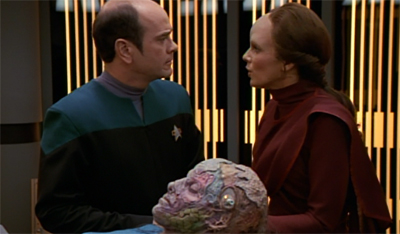
Over her dead body!
As such, Lifesigns is important. It is the first time that the Vidiians are presented as more than just a walking disease; they are humanised, realised. The Doctor comes to fall in love with Denara. He never reacted in horror towards her, but the audience might have. Lifesigns gives us a sense of history and context for Vidiian culture, inviting the viewer to get to know one of the franchise’s most monstrous and predatory aliens in a way that makes it clear that the Vidiians are more than grotesque husks of flesh fashioned in something resembling a human form.
Denara even comes to see herself as a person, reacting with stunned surprise to seeing her own face in the surgical mirror. “I never… I never thought I’d see myself again,” she confesses to Denara. It is an understandable anxiety. If the Phage is a stand-in for AIDS, it is an infection that turns the body against itself. What could be a more literal representation of that than rendering a person incapable of identifying their own form? People living with AIDS in the real world, taking the treatment for it, can recognise how it changes them. Some don’t recognise themselves .
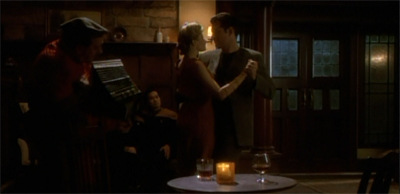
So you think you can dance…?
Lifesigns is fundamentally a story about the “othering” that happens around those living with HIV and AIDS, how people are frequently reduced to monsters and phantoms. Anybody who lived through the panic around AIDS transmission in the nineties will understand the heartbreak of Denara’s story about coming to terms with her disease at a young age. Misinformation about the transmission of HIV served to generate ( and arguably still generates ) a stigma around those diagnosed.
“Do you know what it’s like?” Denara asks the EMH at on point. “What it’s like to be a nine-year old child, and suddenly your best friend doesn’t want to come to your house anymore. And when you ask your mother why, why won’t Mala come and play with me anymore? And she tells you it’s because, it’s because the other children are afraid of you. Listen to me. Before I met you, I was just a disease.” The central point of Lifesigns is a need to see a patient as more than just a breathing affliction.

Heal thyself…
In The AIDS Epidemic , William A. Rushing argued that epidemics like AIDS tended to follow a defined social pattern and behaviour:
When an infectious disease affects only one individual or a few persons, the sociological significance of the fear of contagion is limited to its effects on those who are sick. If the disease is widespread and becomes an epidemic, the fear of contagion and its social effects are more widespread. Then, according to historical studies, a “traumatic shock on a societal level” may occur, accompanied by extreme collective actions: mass migration; desertation, persecution, punitive quarantines, and ostracism of the sick; riots; and accusations that certain groups cause the disease (scapegoating).
Those affected by HIV and AIDS might recognise those collective actions, with popular culture struggling to properly process the outbreak.

Love sick…
By 1996, there was a decline in the number of new cases of HIV/AIDs reported each year . Although it was still a matter of great public concern, the peak of the crisis had passed. At the same time, it was clear that popular culture had not yet figured out how to handle the outbreak. Shows like St. Elsewhere and Beverly Hills 90210 attempted to tell stories about characters living with the condition, but they were very much the exception rather than the rule.
In 1996, E.R. was the most popular show on television. The character of Jeanie Boulet first appeared in January 1995, during the show’s first season; she would become a regular at the start of the following season. At the end of the second season, it was revealed that Boulet had contracted HIV. Actress Gloria Reuben has argued that Boulet was “the first and only regular role on a network television show that was HIV positive.” Certainly, characters living with HIV/AIDS have not been well represented.
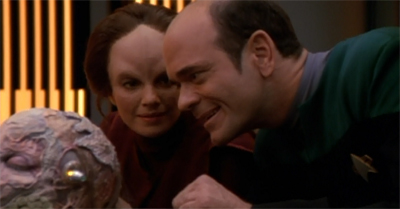
Looking at her body of work…
In March 1994, Tom Hanks won an Oscar for portraying a man infected by HIV in Philadelphia . In March 2014, Matthew McConnaughey won an Oscar for portraying a man infected by HIV in Dallas Buyer’s Club . However, it has been argued that those two performances – spaced twenty years apart – were two of the only times that Hollywood produced a high-profile film with a high-caliber leading actor dealing with the issue of HIV and AIDS . It is not the strongest track record.
So it is great to see Voyager touching on that idea. Of course, the representation in Lifesigns is less than ideal; the Star Trek franchise has a severe lack of openly homosexual characters, making any attempt to explore the cultural context of AIDS somewhat one-sided and narrow-focused. At the same time, Lifesigns avoids a lot of the awkward homophobia that informed the franchise’s later HIV allegory in Stigma . After all, Lifesigns is not too concerned with how Denara contracted the disease in the first place; only in how it relates to how she is seen.

Just a holo!gigalo…
Lifesigns makes a few references to the central allegory. Although the Phage is never confirmed to be transmitted sexually, Denara is awkward with physicality. In conversation with the EMH, Denara stresses the difficulties around intimacy for those infected; she talks about how the EMH transformed her into “a woman [he is] not afraid to touch.” When the holo! gigalo extends his hand to take her to dance, she visibly (and reflexively) recoils. “You’re making the lady nervous,” Neelix warns the holo! gigalo.
(As a side note, the holo! gigalo is a rather odd character. A similar character appeared in The Cloud , played by Luigi Amodeo. In Lifesigns , the holo! gigalo is played Rick Gianasi. The actors are quite distinct; they have different builds, different hairstyles, different facial hair. However, they have similar costumes and make-up. It is interesting to wonder if there is an entire species in the Star Trek universe that specialises in providing vaguely European accented gigalos to dodgy French bars. Forget the Kazon or the Vidiians, there’s an exciting new species.)
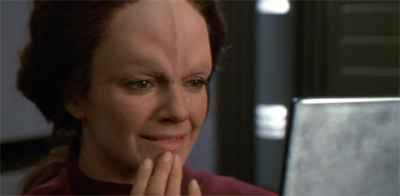
Feeling herself again…
There is something quite tender and beautiful about Lifesigns , particularly in the closing scene. Having been afforded a chance to life in an unblemished holographic facade, Denara returns to her original body. The EMH waits for her in the bar, and the two share a quiet dance together. It is a sequence which underscores a lot of the charming tenderness of Lifesigns , demonstrating that the EMH always did see Denara as a person rather than a walking infection. It is a genuinely moving conclusion to the episode.
Appropriately enough, Lifesigns offers a few little hints about the basic workings of Vidiian society. After all, this is the first time that the villains have seemed like more than just monsters. Denara offers a glimpse of a culture that “spend so much time trying to save lives, they don’t know how to live anymore.” Of course, that is a very charitable description of what we have seen of Vidiian culture, but it makes sense. Lifesigns is populated with other little details about Vidiian life. “Congregating in groups is strictly regulated. It’s considered to be a threat to public health.”
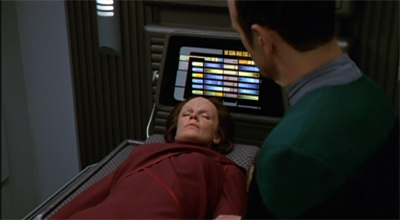
The holomatrix demands a mate!
Denara proves that not all Vidiians are amoral monsters, which is vitally important when dealing with a species designed as an allegory for infection and contamination. “Please understand this disease has been killing my people for hundreds of years,” she explains to Torres. “Trying to stop it has become an obsession, and many of our politicians and scientists have never developed compassion for the people who keep us alive.” Interestingly, Denara suggests more of a centralised Vidiian government than past episodes would imply.
Lifesigns is more than just the story of Denara Pel. It is an episode centring around the EMH. The EMH finds himself falling in love with Denara. As a character who is essentially a computer simulation, the EMH is utterly unready for the emotions that flow from that basic attraction. It is interesting how little the show has actually used the EMH to this point, especially when compared to the use of the character in later seasons. In the first two years of Voyager , it frequently seemed like the production team had no idea what to do with the EMH.

“Doctor, can’t you give me something… to ease my pain… to ease my pain?”
With Lifesigns , it becomes clearer how the EMH is to work. Quite simply, he is to play the role of “outsider processing human emotion.” It is the niche that had been filled by Spock and Data, and Robert Picardo credits it to the eventual success of the character :
I had no idea that the doctor would become such an integral character. In fact when I took the role I told all of my friends that I just got a good job on the new Star Trek show and it will probably run seven years and would put my daughters through college…but I had the worst character on the show. When you accept a role that is described as “colourless, humourless, a computer programme of a doctor” you don’t necessarily have great expectations for how the character will develop. What I didn’t realize, because I wasn’t familiar with Star Trek at the time was that the artificial intelligence characters kind of replaced Spock as the outsider character who is not human but aspires to be human. In the same sense that Data became a breakout character on Star Trek TNG I think the Doctor captured the audience’s imagination and the writers responded by giving me (The Doctor) wonderful things to do.
Of course, this character direction is rather problematic. While the writers on Star Trek: Deep Space Nine had figured out how to develop their own “outsider character” in a direction different to that of Spock and Data, it seemed like Voyager would just recycle Data’s arc. In the fourth season, it would double down on it.
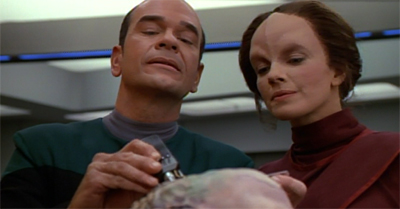
The couple that performs complex neuro surgery together…
As with Death Wish , the viewer can feel the pull of Star Trek: The Next Generation . There is a very comfortable and very familiar feeling to all this. This is not anything particularly new or exciting; instead, it is something that has been done before. In fact, it is worth noting that Lifesigns features the second consecutive appearance of Earth in a Voyager episode; it appeared out the window in Death Wish , and it appears in the holodeck here. It seems that “home” is never too far away.
This is a very traditional and conventional Star Trek arc, one rooted in the franchise’s optimistic humanism. The EMH is growing as a character, and that means embracing his humanity. He is perplexed by the possibility here, but he comes to accept it in later episodes. There is no real twist, no shrewd deconstruction. The EMH’s character arc is so conservative that he winds up creating a perfect heteronormative family for himself in Real Life . The EMH is a more caustic iteration of Data, arguably like Voyager is a more cost-effective iteration of The Next Generation .

“And look, unlike most Voyager guest stars, you’ll get a second appearance!”
To be fair to Robert Picardo and the writers, the EMH never feels entirely like a carbon copy of Data. Most notably, the character is explicitly emotional in a way that Data never was. The tone and mood of Robert Picardo’s performance is entirely distinct from that of Brent Spiner. At the same time, Lifesigns does suggest that the two characters may enjoy journeys that overlap. Rather tellingly, the final season of Voyager would present an EMH-centric version of The Measure of a Man in Author, Author .
Lifesigns also continues the recurring Kazon arc running through the season. As with other episodes in the sequence, it feels like the production team are focusing too heavily on plot-driven continuity rather than character-centric drama. There is a sense that the events in the arc happen because the team wants to write Investigations , rather than because they are good ideas on their own terms. Even after all this time, Lifesigns does nothing to flesh out the motivations of Michael Jonas and Tom Paris.

“Note to self: need to install better lighting in my quarters.”
Instead of explaining why Jonas is helping Seska, the episode instead drops lots of cryptic hints about what is coming. “I have no intention of raising my child on a Kazon ship,” Seska advises Jonas. “One way or another, I’m going to take Voyager. You can either help me, or you can suffer along with Janeway and the others. ” This is the first time that the season has consciously nodded towards the cliffhanger events of Basics, Part I . It is a nice piece of plot set-up, even if it does feel a little bit like the show is contorting to get through all these hoops.
Still, at least the Paris subplot in Lifesigns serves a purpose. It advances the arc noticeably, rather than eating up airtime for the sake of eating up airtime. Scripts like Meld and Dreadnought simply had Paris acting suddenly out of character with no real reason; the character beats in Dreadnought made a bit of sense, but the scenes in Meld rather undercut the claustrophobic tension of the parent episode. Lifesigns ends with Tom Paris assigned to the brig, what really should be a pretty big deal; he is a main character, and he doesn’t get out at the end of the episode.

Paris’ insubordination really floors Chakotay…
The problem, to be fair, is in the structuring of the episode. The scenes with Paris and Chakotay generally exist quite removed from the primary plot of the episode. As Kenneth Biller complained to Cinefantastique :
We sort of closed that off in twelve beats and then the action story that is continuing comes off a little baffling. You’re watching this show about the doctor and this woman and then suddenly after the third commercial you come back and there are two long scenes of Paris and Chakotay going at it in the mess hall. Suddenly you’re cutting to this guy sending a message to the Kazon. You almost feel as if the engineers have put on another episode.
It really is quite jarring when watched as part of the episode itself. The link between the plots in the teaser feels particularly clumsy. Both threads diverge and never quite intersect or overlap again, even thematically.

“This is almost over, right?”
More than that, the positioning of these scenes is a little awkward. Tom Paris is sent to the brig in what should be the episode’s climactic scene – at least for that arc. However, the show then cuts to Michael Jonas talking with Seska about something that might or might not be happening soon. Even on a basic plotting level, it is clumsy structuring. There is meant to be some mystery around Paris’ behaviour, but making a point to connect it to the only other long-running plot element makes it clear that there is a strong link between the two.
More than that, the story continues around it as if nothing happened. After Paris is escorted to the brig, the plot with the EMH and Denara picks up as if nothing has happened. The audience gets the entirety of the climax of Denara’s plot, from her attempts to murder her own body to her final scene dancing with the EMH in the holodeck. By the time the closing credits arrive, it seems like the show has forgotten about the situation with Paris. (It may have been more effective to put a short scene of Paris in the brig as the penultimate scene, integrating the plot better.)

The bare bones of an arc…
Still, this isn’t too severe a problem; it does not diminish Lifesigns too severely. Lifesigns continues a late-season rally for the second season of Voyager . There are some larger questionable trends around the episode, particularly in its handling of the EMH and the difficulty with the Paris arc, but it is still more interesting than anything in the first stretch of the season.
You might be interested in our other reviews from the second season of Star Trek: Voyager :
- Initiations
- Projections
- Non Sequitur
- Parturition
- Persistence of Vision
- Dreadnought
- Investigations
- Resolutions
- Basics, Part I
Episodes produced during the second season , but carried over to the third:
- Basics, Part II
- False Profits
- Sacred Ground
Share this:
Filed under: Voyager | Tagged: denara pel , emh , HIV , kazon , lifesigns , paris , phage , star trek , star trek: voyager , stigma , vidiians , voyager |
15 Responses
Robert Picardo is capable of elevating almost any script, though perhaps not Virtuoso, so it is always nice when he actually gets a good episode. This episode always strikes me how to do an emotional episode right. The emotions are not shoved in your face like the later Doctor episode, Real Life. I am not crazy about the cheesy date in a truck though. It would have been more interesting if they had actually gone to a recreation of the Vidiian home world at its peak.
“I am not crazy about the cheesy date in a truck though.”
It’s very Data, isn’t it? Just like his Brady Bunch family in “Real Life.”
The review brings up a good point, though. The Doctor is written as a robot. But Picardo is obviously gunning for something more human. In essence, the script gets a final rewrite from the actor. He comes across as very unsure because he’s not human. Not as a robot discovering love.
You don’t think of Robert Picardo as “romantic lead” but he’s very romantic in the role. Moriarty was a sweeping, romantic character and he was a hologram, too.
Also, laugh at the irony of state-of-the-art robots expressing their affection in archaic ways.
Picardo is great. I’d honestly put Picardo as the best actor for the show’s first three seasons. I’m not sure whether he or Ryan can claim credit for the final four. (Picardo is probably better, but does get better material and doesn’t come with as much baggage. Then again, if Picardo can seel “Emergency Command Hologram”, he can do just about anything.)
A 57 Chevy is a car, not a truck William. Imagine trying to have a date in a truck!
Yep, I feel like the Vidiians were sadly under-explored as an alien menace/threat. Although it’s hard to imagine how much more could have been layered on them, I would have liked a little more world-building. As you suggested, the holodeck would have been a nice way to that.
I really liked this episode (I watched it for the 1st time a few weeks ago), though it certainly does feel undercut by the “Real Life” episode soon after. It would have been nice to have had the Doctor make his holographic family Vidiian or a comment from the Doc about how his past experiences made him want a family. But no, just one of those episodic story-telling moments.
Ah, yes. But this is Voyager we’re talking about. It’s a minor miracle that Pel reappears in Resolutions. Asking the writers to remember her the following season would be too much, I fear.
Lifesigns is not the first VGR episode to introduce the Doctor to romance. There was also Freya in Heroes and Demons, but this is where the Doctor really experiences love for the first time. In fact, Robert Picardo was told later in the fourth season that he and Denara had sex during Lifesigns, something that considerably surprised him (and that would explain the “addition” he made to his program that he tells EMH MK2 about in Message in a Bottle).
It’s curious that Denara tries to kill herself, and then the week before we had Q assisting Quinn’s suicide. And on DS9, Worf tried to kill his brother Kurn in Sons of Mogh. Are we seeing a theme here?
Although I liked Lifesigns (except for the Paris and Chakotay scenes which are odd and ill-fitting), it never comes up that Denara may not feel the same way about the Doctor once she goes through with the transfer and becomes flesh and blood again. It would have provided an interesting mirror to what she was telling the Doctor, how he’ll never feel the same way about her after the transfer.
I really like Kes’s line “Romance is not a malfunction”. But I wonder if they got that from Short Circuit. When Ally Sheedy is trying to convince Steve Guttenberg that No 5 is alive, she tells him “life is not a malfunction”. I’m surprised there’s no picture of the Doctor and Denara dancing at the end; I even have the perfect caption, The Dancing Doctor(s). If Spock, Data and the EMH are outsiders processing human emotions, then Odo is surely the outsider processing humanoid emotions. And you wrote Denara confesses to Denara and not the Doctor, Darren.
That’s an interesting recurring motif on the suicides. I had completely missed that, but you’re right. I seems the franchise had quite a morbid fascination for a while.
As well as Hard Time when O’Brien nearly ended it all rather then live with what he had been through.
It’s an early example of DS9 and Voyager sharing similar plotlines but doing completely different things with them.
“could care less” s/b “couldn’t care less”
Good spot! Corrected.
Something interesting about this episode is how the Paris insubordination plot is so bad it even clashes with the episode’s other scenes involving Tom Paris! Good episode otherwise tho
Yep. It’s shockingly ill-judged. “Paris is a jerk… except when he needs to appear in the primary plot, as a friend to the EMH.”
Leave a comment Cancel reply
This site uses Akismet to reduce spam. Learn how your comment data is processed .
Recent Posts
- 373. Pirates of the Caribbean: The Curse of the Black Pearl (#225)
- 371. Poor Things (#246)
- 370. Dune: Part Two (#12)
- 369. Memento (#57)
- 368. Monty Python and the Holy Grail (#154)
Recently tweeted…
- "I Simply Am Not There": The Existential Horror of Eighties Excess in "American Psycho"...
- X-Men: Operation Zero Tolerance (Review/Retrospective)
- Star Trek: Voyager (Reviews)
- Crime and Pun-ishment: The Art of the CSI One-Liner
- Star Trek: Deep Space Nine (Reviews)
Available at…

Blogs Well Worth Your Time
- 1001 Must See Films
- Andrew at the Movies
- Anomalous Material
- Cut the Crap Movie Reviews
- Encore Entertainment
- Fandango Groovers
- FlixChatter
- Four of Them
- It Rains… You get Wet…
- Jameson Cult Film Blog
- Jar Watches Films
- Let's Go To The Movies
- M. Carter at the Movies
- Marshall and the Movies
- Movie News First
- Musings from a Man Lost in La Mancha
- Never Mind Pop Film
- Paragraph Film Reviews
- Roger Ebert's Journal
- Ross v. Ross
- Scannain.com
- Screenwriter (Donald Clarke, Irish Times)
- Strange Culture
- The Film Cynics
- The Pompous Film Snob
- The Projection Booth
- Things That Don't Suck
- Too Busy Thinking About My Comics
- Undy a Hundy
Film Nerd Resources
- CinemaBlend (News)
- Internet Movie Database
- Rope of Silicon
- The Guardian Film Blog
- James Berardinelli
- Roger Ebert
Email Subscription
Enter your email address to follow this blog and receive notifications of new posts by email.
Email Address:
Sign me up!
Blog at WordPress.com. WP Designer.
- Already have a WordPress.com account? Log in now.
- Subscribe Subscribed
- Copy shortlink
- Report this content
- View post in Reader
- Manage subscriptions
- Collapse this bar

- Web Channels
- Star Trek: Voyager

Voyager rescues a dying Vidiian and during the process of trying to save her life, the Doctor's adaptive program allows him to experience romantic feelings for the first time. Lt. Paris starts objecting to his treatment on Voyager and ends up assaulting Chakotay.

Martha Hackett
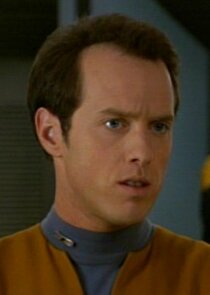
Raphael Sbarge
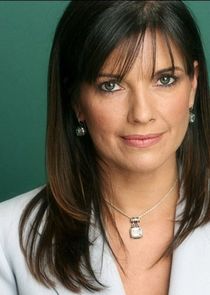
Michael Spound

Rick Gianasi
Cast appearances.
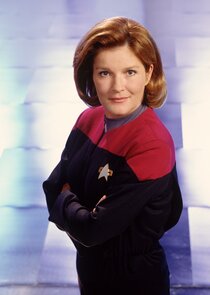
Kate Mulgrew
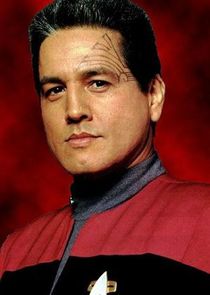
Robert Beltran
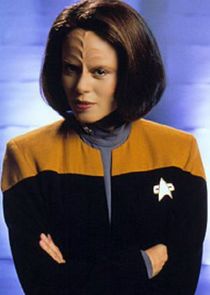
Roxann Dawson
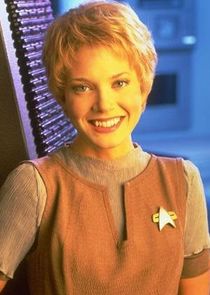
Jennifer Lien
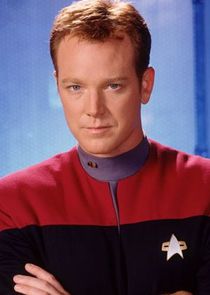
Robert Duncan McNeill

Ethan Phillips
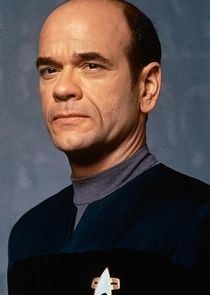
Robert Picardo
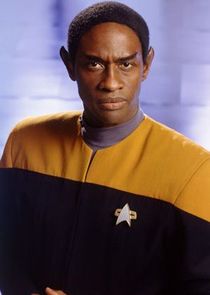
Garrett Wang
Episode discussion.
No comments yet. Be the first!
- Feb 26, 1996
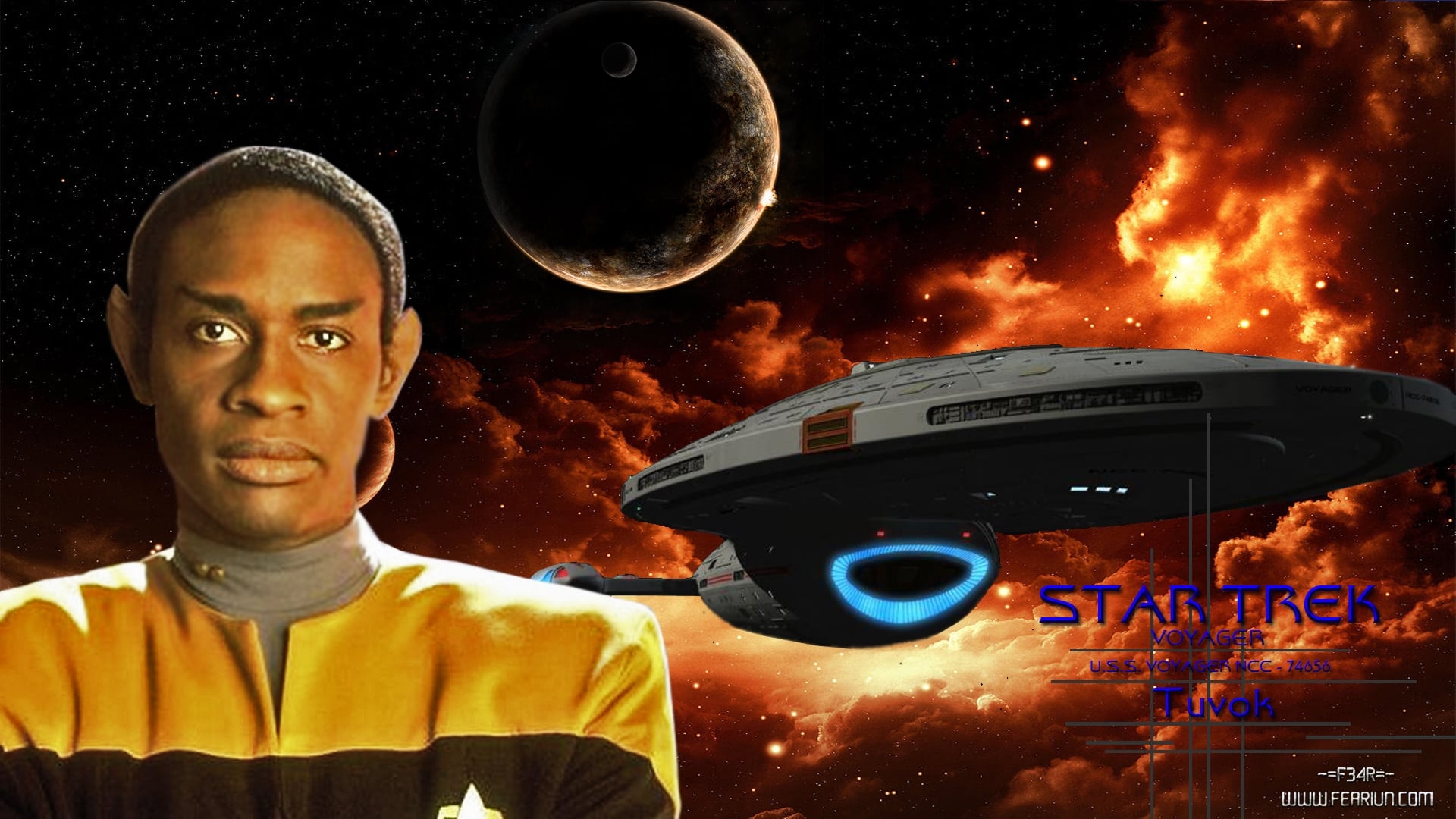
Summary Star Trek: Voyager follows the adventures of the Federation starship Voyager, which is under the command of Captain Kathryn Janeway.Voyager is in pursuit of a rebel Maquis ship in a dangerous part of the Alpha Quadrant when it is suddenly thrown 70,000 light years away to the Delta Quadrant. With much of her crew dead, Captain Janeway is ... Read More
Directed By : Cliff Bole
Written By : Gene Roddenberry, Rick Berman, Michael Piller, Jeri Taylor, Kenneth Biller, Lisa Klink
Where to Watch
Created By : Rick Berman, Michael Piller, Jeri Taylor
Season Episodes
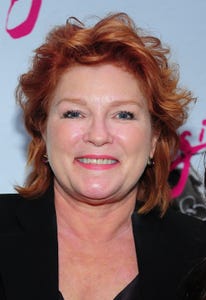
Kate Mulgrew
Capt. kathryn janeway, captain jenkins, shannon o'donnell.
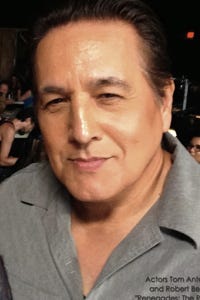
Robert Beltran
Cmdr. chakotay, cmdr. katanay.
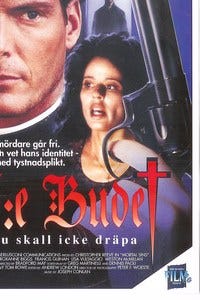
Roxann Dawson
Lt. b'elanna torres, b'elanna torres, dreadnought.
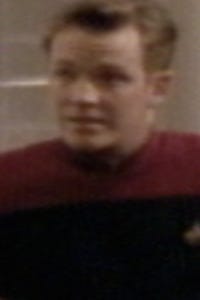
Robert Duncan McNeill
Lt. tom paris, ensign tom paris, lt. (j.g.) tom paris.
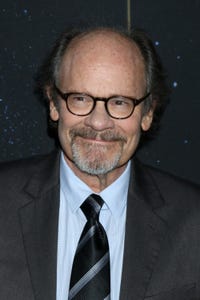
Ethan Phillips
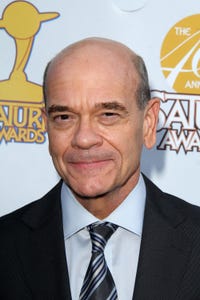
Robert Picardo
The doctor, dr. lewis zimmerman, equinox emh.
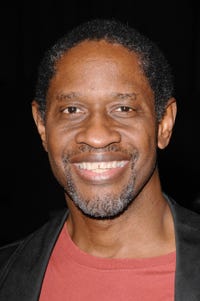
Lt. Tuvok, Tulak, Tuvok
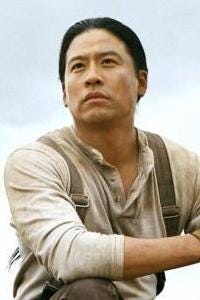
Garrett Wang
Ensign harry kim, ensign kymble, tarik ergin, lt. ayala, satan's robot, security guard.
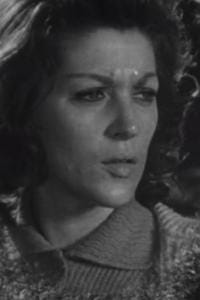
Majel Barrett
Voyager computer, computer voice, computer.

Seven of Nine, Three of Eight, Two of Three
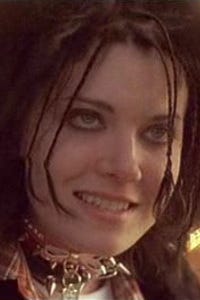
Jennifer Lien
Kes, palaxia, richard sarstedt, william mckenzie, ankari trader, crewman henard, starfleet admiral, scarlett pomers, naomi wildman.
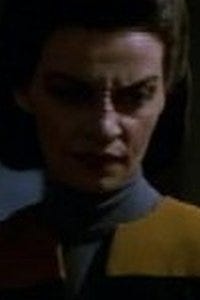
Martha Hackett
Susan henley, ensign brooks, manu intiraymi, jennifer gundy, science division officer, ensign, alexander enberg, ensign vorik, third malon engineer, susan lewis, operations division officer, transporter technician, mikhal traveler, user reviews.
There are no user reviews yet. Be the first to add a review.
Related Shows
Samurai Jack
Genndy Tartakovsky's Primal
Battlestar Galactica (2003)
Game of Thrones
The Pacific
Harley Quinn
Buffy the Vampire Slayer
The Last of Us
Scott Pilgrim Takes Off
The Guardians of the Galaxy Holiday Special
Star Wars: Visions
The Legend of Vox Machina

Star Trek: Strange New Worlds
The Long Road Home
From the Earth to the Moon
The Tourist
Related News

What to Watch on Prime Video Right Now
Jason dietz.
Get a list of the best movies and TV shows recently added (and coming soon) to Amazon's Prime Video, updated frequently.

What to Watch on Netflix Right Now
Get a list of the best movies and TV shows recently added (and coming soon) to Netflix, updated frequently. You can also find a list of titles leaving Netflix this month.

What to Watch on Hulu Right Now
Get a list of the best movies and TV shows recently added (and coming soon) to Hulu, updated frequently.
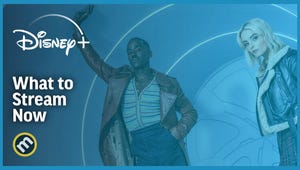
What to Watch on Disney+ Right Now
Get a list of the best movies and TV shows recently added (and coming soon) to Disney's streaming service, updated frequently.
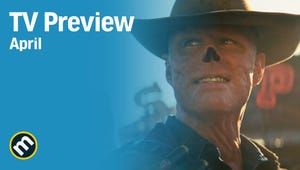
April TV Preview (2024)
The month ahead will bring a series adaptation of the videogame Fallout plus Netflix newcomer Ripley, Park Chan-wook's miniseries The Sympathizer, a sequel to Emmy winner The Jinx, Idris Elba's weirdest project to date, and more.
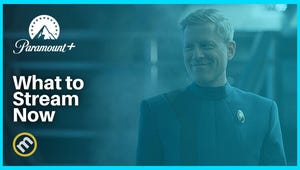
Delete Episode
Star Trek: Voyager
Cast & Crew
Dr. Danara Pel
Raphael Sbarge
Michael Jonas
Martha Hackett
Michael Spound
Rick Gianasi
Information
© 2009 CBS Corp. All Rights Reserved.
Accessibility
Copyright © 2024 Apple Inc. All Rights Reserved.
Internet Service Terms Apple TV & Privacy Cookie Policy Support
Lifesigns Stardate: 49504.3 Original Airdate: February 26 1996
<Back to the episode listing
Star Trek ® is copyright of CBS Studios Inc . Copyright © 1966, Present. The Star Trek web pages on this site are for educational and entertainment purposes only. All other copyrights property of their respective holders.
USS Voyager comes across a Vidiian ship with one inhabitant inside. Captain Kathryn Janeway orders the beaming aboard of the sole survivor, Denara Pel, who is taken to see the Doctor. The Doctor transplants the mind of Denara to a holographic body so that the Vidiian can see what she would look like had it not been for the Phage. Kes notices the attraction to Denara shown by the Doctor and wants to know more. Tom Paris who has been acting slightly strange suggests the Doctor takes Denara to one of his holodeck areas which the Doctor agrees to. Denara doesn't want to return to her body but the Doctor persuades her that its the only way before her body dies. Before Denara returns to the body, the Doctor takes her one more time to the holodeck.
Episode Details
Copyright : Paramount
Last Modified : 19th March 2023
Comments and Questions
There's no register feature and no need to give an email address if you don't need to. All messages will be reviewed before being displayed. I may add your comment onto the end of the appropriate page. Comments may be merged or altered slightly such as if an email address is given in the main body of the comment. You can decline to give a name which if that is the case, the comment will be attributed to a random star. A name is preferred even if it's a random made up one by yourself. If you give an email address, you may receive an email notifying you when someone else has added a comment to the same page. In the email will be a link to unsubscribe to further notifications. Email address is optional.
- Cast & crew
- User reviews
Star Trek: Voyager

Pulled to the far side of the galaxy, where the Federation is seventy-five years away at maximum warp speed, a Starfleet ship must cooperate with Maquis rebels to find a way home. Pulled to the far side of the galaxy, where the Federation is seventy-five years away at maximum warp speed, a Starfleet ship must cooperate with Maquis rebels to find a way home. Pulled to the far side of the galaxy, where the Federation is seventy-five years away at maximum warp speed, a Starfleet ship must cooperate with Maquis rebels to find a way home.
- Rick Berman
- Michael Piller
- Jeri Taylor
- Kate Mulgrew
- Robert Beltran
- Roxann Dawson
- 427 User reviews
- 26 Critic reviews
- 33 wins & 84 nominations total
Episodes 168

Photos 2084

- Capt. Kathryn Janeway …

- Cmdr. Chakotay …

- Lt. B'Elanna Torres …

- Lt. Tom Paris …

- The Doctor …

- Lt. Tuvok …

- Ensign Harry Kim …

- Lt. Ayala …

- Voyager Computer …

- Seven of Nine …

- William McKenzie …

- Naomi Wildman

- Ensign Brooks

- Science Division Officer …
- Jeri Taylor (showrunner)
- All cast & crew
- Production, box office & more at IMDbPro
Stellar Photos From the "Star Trek" TV Universe

More like this

Did you know
- Trivia When auditioning for the part of the holographic doctor, Robert Picardo was asked to say the line "Somebody forgot to turn off my program." He did so, then ad-libbed "I'm a doctor, not a light bulb" and got the part.
- Goofs There is speculation that the way the Ocampa are shown to have offspring is an impossible situation, as a species where the female can only have offspring at one event in her life would half in population every generation, even if every single member had offspring. While Ocampa females can only become pregnant once in their lifetime, if was never stated how many children could be born at one time. Kes mentions having an uncle, implying that multiple births from one pregnancy are possible.
Seven of Nine : Fun will now commence.
- Alternate versions Several episodes, such as the show's debut and finale, were originally aired as 2-hour TV-movies. For syndication, these episodes were reedited into two-part episodes to fit one-hour timeslots.
- Connections Edited into Star Trek: Deep Space Nine: Inter Arma Enim Silent Leges (1999)
User reviews 427
- harrypothead42024
- Jan 19, 2019
- How many seasons does Star Trek: Voyager have? Powered by Alexa
- Why do the Nacelles of the Voyager pivot before going to warp?
- Is it true there is a costume error in the first season?
- How many of Voyager's shuttles were destroyed throughout the course of the show?
- January 16, 1995 (United States)
- United States
- Heroes & Icons
- Memory Alpha, the Star Trek wiki
- Star Trek: VOY
- Donald C. Tillman Water Reclamation Plant - 6100 Woodley Avenue, Van Nuys, Los Angeles, California, USA
- Paramount Television
- United Paramount Network (UPN)
- See more company credits at IMDbPro
Technical specs
- Runtime 44 minutes
- Dolby Digital
Related news
Contribute to this page.

- See more gaps
- Learn more about contributing
More to explore

Recently viewed

Message in a Bottle (episode)
- View history
Seven of Nine finds an abandoned subspace relay network that has the ability to send a message, or in this case The Doctor, to a Starfleet ship detected in the Alpha Quadrant.
- 1.2 Act One
- 1.3 Act Two
- 1.4 Act Three
- 1.5 Act Four
- 1.6 Act Five
- 2 Memorable quotes
- 3.1 Story and script
- 3.2 Cast and characters
- 3.3 Production
- 3.4 Visual effects
- 3.5.1 Other Voyager episodes
- 3.5.2 Other series
- 3.5.3 Errors
- 3.6 Reception
- 3.7 Video and DVD releases
- 4.1 Starring
- 4.2 Also starring
- 4.3 Guest Stars
- 4.4 Special Guest Star
- 4.5 Co-Stars
- 4.6 Uncredited Co-Stars
- 4.7 Stand-ins
- 4.8.1 Dedication plaque references
- 4.8.2 Non-canon reference
- 4.9 External links
Summary [ ]
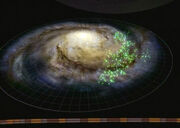
The Hirogen communications network
Lieutenant B'Elanna Torres and Commander Chakotay discuss Torres' dissatisfaction with the former Borg drone , Seven of Nine . Torres has run out of patience with Seven's aloof, arrogant attitude and is furious. Chakotay, on the other hand, doesn't want to hear it and advises her to start acting like the senior officer that she is. He orders her to find a way to deal with Seven in a professional manner.
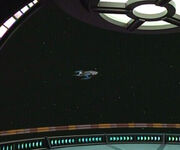
The detected Starfleet vessel, The USS Prometheus
While discussing this, Seven hails Chakotay to the astrometrics lab . Chakotay meets Captain Kathryn Janeway outside astrometrics. She too has been hailed by Seven. They share a bemused expression as they enter. Chakotay asks Seven, who is busy at the console, what this is about. She shows them a ship on the astrometrics viewscreen that is a Starfleet vessel.
Act One [ ]
Seven informs them that the ship is in the Alpha Quadrant . She informs them that she has been able to detect the ship because of the presence of a huge relay station network . The network is apparently abandoned but it extends all the way to the edge of the Alpha Quadrant. The ship, she tells them, is in range of the network sensors on that far end.
The two officers realize that they now have an opportunity to communicate with Starfleet, which they have not been able to do since being brought to the Delta Quadrant , four years earlier. Chakotay asks if a message can be sent to the ship. Seven confirms, though she adds that some modifications to their own transmitters must be made first. The message must be sent within the next 41 minutes or the ship will move out of range. Janeway orders the modifications be made immediately. However, the signal is too weak to reach the vessel. Lieutenant Tom Paris suggests using a stronger type of signal, one that would not degrade so quickly. Torres suggests a holographic data stream. That is when they remember The Doctor , the ship's Emergency Medical Hologram . Torres rushes to sickbay and, before The Doctor can even finish asking what is happening, she transfers him to his mobile emitter and runs with it to astrometrics. Janeway arrives in astrometrics and explains the situation to The Doctor when he is reactivated there. There, he is downloaded and transmitted.
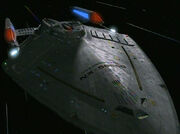
The USS Prometheus
The Doctor materializes on the Starfleet vessel's sickbay, which seems to be empty. He calls to anyone, but gets no answer. He queries the ship's computer and is very pleased to find that his transmission was successful; he is indeed aboard the target vessel, in the Alpha Quadrant. He further asks the ship's computer about the vessel's identity, and learns that it is the USS Prometheus .
Searching sickbay, he finds a crewman dead on the floor. He also finds an ensign , barely alive. Their uniforms are different from those of Voyager 's crew. The ensign has sustained severe phaser burns. The Doctor manages to revive him and asks him what happened. His response, just before he dies, is that Romulans have taken over the ship.
Act Two [ ]
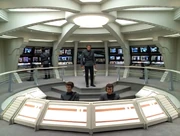
The Romulan hijackers
On the Prometheus ' bridge, Romulans man all stations. In sickbay, The Doctor confirms what the dead ensign told him: 27 Romulans are aboard and all Starfleet personnel are dead. He then asks the computer about the ship itself. He learns the ship is an experimental prototype designed for deep space tactical assignments. It is equipped with technologies that Starfleet is experimenting with including regenerative shielding , ablative armor , and a multi-vector assault mode .
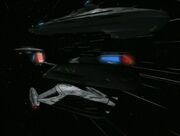
The Prometheus 's multi-vector assault mode
The approaching Federation starship arrives and engages the Prometheus . On the bridge, the Romulan commander orders the "multi-vector assault mode" engaged. The lighting on the bridge (and in sickbay, much to The Doctor's surprise) turns blue . The computer counts down from ten to one, the time of what it terms "auto-separation."
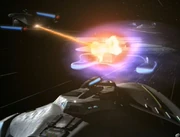
The Prometheus disables the Starfleet vessel
The ship separates into three sections: the saucer and two stardrives , all battle-ready and warp-capable . In effect, the one ship becomes a small squadron. Rekar orders the Prometheus to engage the other Federation ship, the USS Bonchune . The three sections surround and attack the Bonchune , disabling it. During the battle the Prometheus ' bridge takes a hit and a Romulan hijacker is badly injured. As the three sections reform, Rekar orders the injured Romulan taken to sickbay.
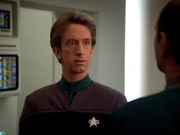
The Prometheus EMH encounters The Doctor
Nevala enters sickbay with her injured hijacker. The Doctor immediately puts on his best bedside manner. She is instantly suspicious, demanding to know who activated him. He lies that she did when she walked through the door. She is still suspicious because he is, after all, a Starfleet program. He assures her his primary directive is to treat anyone requiring it, Federation citizen or not, friend or enemy.
As soon as she has gone, The Doctor activates the ship's EMH – which is a Mark II, as opposed to a Mark I, The Doctor's designation.
Act Three [ ]
The Mark II stands in sickbay regarding The Doctor with contempt, calling him an inferior EMH program, much to The Doctor's chagrin, and tries to hail security . The Doctor immediately stops him and explains the situation of the Prometheus and of his own ship, Voyager . He explains Voyager is over 60,000 light-years away, and was pulled into the Delta Quadrant four years ago. With a forceful tone, he convinces his reluctant counterpart to help him take back the ship from the Romulans. He asks if the Federation is at war with the Romulans. The Mark II responds that they are not and the Romulans have had nothing to do with the Dominion War . Confused, The Doctor asks who the Dominion is but the Mark II tells him that it is a long story. They begin to treat the injured Romulan together.
Voyager holds position while the crew awaits The Doctor's return. Janeway and Chakotay write letters to their loved ones, though they know that The Doctor's return will not necessarily mean establishing a communications link with Starfleet. Paris has been assigned to sickbay until The Doctor's return as he is the only other trained medic aboard Voyager .
The Prometheus heads for Romulan space at warp speed . The Mark II informs The Doctor that the ship is capable of a cruising speed of warp 9.9 and no other ship in Starfleet can do this. Thus, there is no chance any Starfleet ship can intercept and rescue them meaning that they are on their own. They come up with a plan to take back the ship: release an anesthetic into the ventilation system .
Rekar orders a course change. They were previously headed for Romulus , but he has decided that they should instead rendezvous with the Tal Shiar , the intelligence service of the Romulan Star Empire . The others object and begin to argue with Rekar. During the argument The Doctor, pretending to scan them, surreptitiously attempts to access environmental controls. Rekar notices him and accosts him. Rekar then checks his scanner and sees that he has not scanned anything; his plan has been foiled.
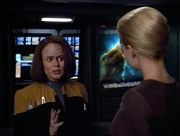
" You're rude. " Torres remonstrates Seven of Nine about the former drone's attitude
On Voyager , Seven of Nine enters astrometrics to find Torres there. They get into an argument in which Torres tells Seven that the way she speaks to other crewmembers is unacceptable.
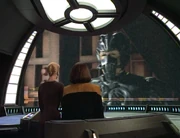
Voyager is warned to cut its link with the relay network
As Seven considers these comments, a transmission comes through. A humanoid alien 's image appears on the lab's viewscreen. The alien is wearing an armored helmet and an armored mask that covers his nose and mouth. He gruffly demands their identity. The man angrily tells them that the network is in fact, owned by the Hirogen . Torres apologizes and explains that they thought the network was abandoned. She attempts to explain why they are using it but he is not interested in her explanation and orders them to terminate their link before ending his communication.
Act Four [ ]
The Doctor is being interrogated by Rekar, who believes that The Doctor is either a spy or saboteur. Rekar does not believe a hologram to be capable of performing such action independently and he demands to know who is operating him. Nevana enters and reports that she has found the transmission log that shows when The Doctor came aboard. She notes that the transmission that brought him on board has a Starfleet signature.
The log does not indicate its origin or who sent it so they demand this information from The Doctor. He tells them part of the truth, that he was sent from the Delta Quadrant. Rekar and Nevala do not believe him and decide that stronger action is necessary. They will extract all his algorithms and analyze his subroutines individually. This action would severely damage or destroy his holomatrix , killing him. However they do not get beyond talking about it as they suddenly begin to cough and gag before collapsing, unconscious.
The Mark II materializes. He has succeeded in releasing the neurozine gas into the ventilation system. Their next step is to get to the bridge and turn the ship around. On the bridge, The Doctor finds a way to make the ship slow from warp speed but his method causes a warp core overload. Fortunately, he manages to stop the overload before a warp core breach occurs.
However after one disaster was averted, sensors indicate that three Romulan warbirds are headed straight toward them.
Meanwhile on Voyager , Seven and Torres work to reestablish the link with the Hirogen communications network in the astrometrics lab. Janeway has joined them to help with their work. Before they can finish, the Hirogen male appears again on the viewscreen. He introduces himself as Idrin and angrily reminds them of his initial warning to leave the network alone. Janeway tries to get him to listen, explaining that they are using it to get a message to their people but he is uninterested. He again proceeds to jam their link.
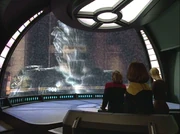
Idrin is shocked by Seven of Nine
Realizing that reasoning with Idrin won't work, Seven shocks him with a feedback surge along the link, knocking him out. Janeway orders them to keep watching for The Doctor's return and to alert her if the Hirogen troubles them again. With a stern look at Seven, she leaves the astrometrics lab. After making sure the captain is fully out of earshot, Torres tells Seven that she approved of her action and Seven casually thanks her.
In sickbay, Kim began programming the replacement EMH. He loads medical texts into the program, and the replacement EMH begins to recite Grey's Anatomy from chapter 1. However, the hologram overloads from all the data and crashes, deactivating it. Kim then downloads Grey's Anatomy for Paris to study himself.
Aboard the Prometheus , The Doctor and the Mark II try to get the ship moving again but without success. A hail comes from one of the warbirds. Keeping the viewscreen off, The Doctor answers, trying to fool them into thinking that he is the Romulan commander – he fails miserably. The warbirds open fire on the ship. The Prometheus ' regenerative shields rapidly begin to fail as the two holograms do not have the required expertise to operate them properly. Sensors detect more ships approaching.
The holograms are relieved to discover that the new ships are Starfleet vessels. The ships, two Defiant -class vessels and one Akira -class starship , are seen approaching at warp speed. They slow and join the fight but the holograms' relief quickly changes to horror when the Starfleet ships, instead of attacking the warbirds, fire on the Prometheus . The attempt to hijack the ship has been discovered by Starfleet Command .
Act Five [ ]
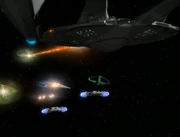
The battle for the Prometheus
The Mark II tries to hail the Starfleet ships but the Romulans hijackers scrambled the comm frequencies, making this impossible. The two holograms are left with no choice but to defend themselves. At first, they accidentally hit a Starfleet ship with a torpedo, but then they prove that the ship is no longer under enemy control by attacking the D'deridex -class . The Prometheus separates into its three battle-ready components. The three sections attack a warbird. With the computer in control, the power of the vessel is very effectively demonstrated against the targeted ship. The warbird is quickly destroyed and the other warbirds retreat. The Doctor and the Mark II grandiosely congratulate each other before being interrupted by two heavily-armed Starfleet security officers being beamed aboard.
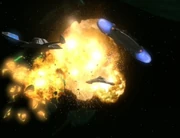
The Romulans are forced to retreat
In Voyager 's astrometrics lab, Seven of Nine detects a transmission coming through the relay network, from the Alpha quadrant. She informs Torres that the transmission has a holographic subroutine . Torres informs the bridge about the return of The Doctor.
Janeway, Chakotay, and Lieutenant Commander Tuvok arrive in sickbay as The Doctor materializes. He explains that he accomplished his mission and then gently informs Janeway that he spoke with Starfleet Command. Apparently, they had declared Voyager lost 14 months previously but he corrected that error, telling them that the ship is very much intact, and that the crew is searching for a way to return.
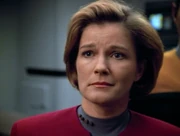
No longer alone
Starfleet will be contacting the crew's families to inform them of the news and have immediately begun to seek a way to retrieve them, and will not stop until they succeed in doing so. He ends by telling Janeway that Starfleet asked him to pass on a message: "You're no longer alone." Janeway emotionally remarks that after hearing this, "60,000 light years seems a little closer today."
Memorable quotes [ ]
" We need to take control of this situation! " " I'm a doctor, not a commando ! " " It's time you became a little of both. "
" Is the Federation at war with the Romulans? " " No. The Romulans haven't gotten involved in our fight with the Dominion. " " The who…?" " (Takes breath to explain, then pauses and changes his mind) Long story."
" What did you feed them anyway? " " Rodeo Red's Red-Hot, Rootin'-Tootin' Chili ."
" I have even had sexual relations. " " Sex, how's that possible? We're not equipped… " " Let's just say I made an addition to my program. "
" I'm a pilot, Harry, not a doctor ! "
" We're not afraid you're going to assimilate us, we're just not used to… you just… you're rude." " I am rude…"
" Four years ? No wonder you're delusional – your program's degrading after being active so long! " " I assure you, I am in perfect health! I was saving Voyager from annihilation when you were only a gleam in your programmer's eye! Now are you going to help me take back this ship or not!?" " (Pauses, then says with some gusto) Get me the thrombic modulator . "
" You are nothing but a computer-generated projection. I find it hard to believe you're capable of taking these actions independently. " " How flattering. " " Tell me who is operating your program. Is it someone on this ship? A Starfleet crew member we missed? Or one of my own men? " " Paranoia is a way of life for you, isn't it? "
" You know, you really should keep a personal log; why bore others needlessly? "
" Mild shock? Not bad! " " Thank you. "
" Stop breathing down my neck! " " My breathing is merely a simulation. " " So is my neck, stop it anyway! "
" Is this a thruster control? " " Don't touch it! We don't know what it does! It could be the self-destruct! "
" Beep beep beep, beep beep beep? I've never heard that one before. "
" The secondary gyrodyne relays in the propulsion field inter-matrix have depolarized. " " In English! " " I'm just reading what it says here! "
" Our viewscreen is non-operational. We've had some trouble with… Starfleet commandos… "
" Identify yourself. " " (whispering) You first. " " You first. "
" What are they doing?! " " Firing on us! " " They must think Romulans are on board! " " They're right! "
" You hit the wrong ship! " " It wasn't my fault! " " Well, then whose fault was it, the torpedo's?! You're supposed to tell it what to do! "
" My brilliant existence cut short… no time to explore the universe… no time to smell the roses… no time for…sex… "
" Doctor, we've done it! Two holograms alone, Romulans on one side, Starfleet on the other, alarms beeping everywhere! " " EMH Mark II; newborn but filled with courage! " " EMH Mark I; armed with years of experience! " " Together they emerge triumphant! " " The end. "
" You got through to Starfleet? " " I spoke directly with Headquarters. Apparently, Voyager was declared officially lost 14 months ago. I set the record straight. I told them everything that's happened to this crew. They said they would contact your families to tell them the news and promised that it may take years, but they won't stop until they find a way to get Voyager back home. And they asked me to relay a message. They wanted you to know you're no longer alone. " " 60,000 light years… seems a little bit closer today. "
Background information [ ]
Story and script [ ].
- Robert Picardo made some uncredited, humorous contributions to the script of this episode. Shortly before the end of Star Trek: Voyager 's fourth season , Picardo explained, " I have gotten into the habit of calling [episode writer] Brannon [Braga] with joke suggestions, and I scored pretty well on that particular episode. " ( Cinefantastique , Vol. 30, No. 9/10, p. 85) At about the end of the fifth season , Picardo commented, " I'm still phoning Brannon quite often with potential joke lines, although my record is still 'Message in a Bottle'. I think I had six jokes that were mine, in that episode. " ( Cinefantastique , Vol. 31, No. 11, p. 30) All six of these humorous suggestions were promptly approved for use in the installment. ( Star Trek Monthly issue 45 , p. 17) One specific instance of the suggested jokes was, as described by Picardo himself, "in the scene with […] EMH Mark-2… and my scripted line was 'Stop breathing down my neck.'" ( Star Trek: Voyager Companion (p. ? )) The actor recalled, " I said to Brannon, 'You know, we don't really breathe.' He said, 'It's just a Human expression.' It still troubled me. " ( Cinefantastique , Vol. 30, No. 9/10, p. 85) Picardo consequently requested the addition of two particular lines of dialogue. " I remember calling Brannon, " remarked Picardo, " and suggesting the following two rejoinders: EMH Mark-2 says, 'My breathing is merely a simulation.' To which The Doctor replies, 'So is my neck. Stop it anyway.' " ( Star Trek: Voyager Companion (p. ? ))
- Robert Picardo suspected that he may have influenced some of the episode's jokes without being told he had. " There are even sex jokes which I insist Brannon Braga stole from my convention material, " Picardo declared, " because I've been doing 10 minutes at conventions for a couple of years now about whether or not the holographic doctor is anatomically correct. " ( Star Trek Monthly issue 35 , p. 12)
- The episode's final scene was considerably altered; the scene was first shot in Voyager 's mess hall, with the ship's entire crew, but was subsequently reshot and relocated to sickbay. Explaining why the first version was not used, Robert Picardo stated, " It was too much. Originally, we had all these extras, and it was this big emotional moment. They decided it was too much like The Waltons . We ended up redoing that scene and keeping it small, just with Janeway, [Chakotay] and Tuvok. " ( Cinefantastique , Vol. 30, No. 9/10)
- The final draft of the episode's script was submitted on 26 September 1997 . [1]
- Mitch Suskin was of the opinion that this episode was reminiscent of Star Trek: The Original Series . " In my mind, " Suskin reckoned, " it was the closest thing to the spirit of some of the original Star Trek shows. " ( Cinefantastique , Vol. 30, No. 9/10, p. 80)
- This episode's ending is significant to Star Trek: Voyager in general. Robert Picardo noted of the episode, " Its conclusion kind of changed the tone of our journey […] It was a very important development for the series. " ( Star Trek Monthly issue 45 , p. 13) He also said, " It factored into a number of shows and storylines that came after it. " ( The Official Star Trek: Voyager Magazine issue 18 )
Cast and characters [ ]
- Actor Andy Dick was offered the role of the EMH Mark II after letting Brannon Braga (who was a friend of the performer) know that he would be interested in making an appearance on Star Trek: Voyager . Accounting for his acceptance of the role, Dick recalled, " It just seemed like such a great opportunity. I was a fan of Star Trek , but I'm not what you would call a regular viewer of any of the shows. I just thought it would be a challenge for me to do an episode. " ( The Official Star Trek: Voyager Magazine issue 18 )
- Andy Dick had many other friends who were excited to hear of his upcoming role. " I have many friends who watch the Star Trek shows religiously, " he explained. " They were all psyched when I told them that I was doing Voyager . " ( The Official Star Trek: Voyager Magazine issue 18 )
- Because Andy Dick (who was best known for playing the character of Matthew in NewsRadio ) was not entirely familiar with Star Trek , he prepared for his role here by watching some episodes. Robert Picardo explained, " Clearly he had not really seen the show before he got this episode, so he watched a few episodes and got an idea of the style of the show, because he's on a situation comedy […] And even though we were setting up to do a funny Star Trek episode, there's a certain style to our kind of performance that he wanted to acquaint himself with, which he [partly] did from watching the show. " ( Star Trek Monthly issue 35 , p. 11)
- Indeed, although Andy Dick found that he extremely liked his Voyager character, he also found that portraying the EMH Mark II took him into unfamiliar territory. " I was right in thinking it would be a challenge for me, " Dick admitted. " It was really an eclectic style of acting. It's like doing a French period drama and then doing Shakespeare . It was completely different from what I had done before. I mean, there's no comparing how we do NewsRadio to how they do Voyager . None […] The characters are so different, too […] As with Shakespeare, you have to stay within boundaries when you do a Star Trek show. The words are different; the style is different. I wanted to challenge myself and try that, too. " He joked, " It was really like taking a class in Trekker-ism. " ( The Official Star Trek: Voyager Magazine issue 18 )
- Other difficulties were caused by the fact that, although Andy Dick normally wore glasses (including on NewsRadio ), he found that he couldn't do so here. He said of his Voyager appearance, " One of the strangest things about doing it was that I couldn't wear my glasses […] I was tripping down steps and bumping into things all the time. It was really funny. " ( The Official Star Trek: Voyager Magazine issue 18 )
- On the other hand, Andy Dick appreciated that he was made to feel welcome on the Voyager set. He reminisced, " Everybody was really nice to me […] I had a great time. " ( The Official Star Trek: Voyager Magazine issue 18 )
- A particular relationship that Andy Dick valued was with Robert Picardo. " Robert Picardo was so awesome! " Dick raved. " He helped me so much, getting me to relax and helping me get that Star Trek jargon right. I don't think I could have pulled it off if he hadn't been there. Robert was hysterical. He's probably funnier than I am. He had me and the crew cracking up all day. " ( The Official Star Trek: Voyager Magazine issue 18 )
- Early in their working relationship, Robert Picardo and Andy Dick teased one another about each others' surnames. During production, Picardo remarked, " My favorite Andy Dick story is this. About three or four days into the shooting he says to me, 'So your name is Picardo. It's so close to Captain Picard . Do you get teased a lot about that?' And I said, 'Your name is Andy Dick, and you're going to make fun of mine?' So he laughed – apparently he has a sense of humor. I don't think you can grow up with a name like that and not have a healthy sense of humor. " ( Star Trek Monthly issue 35 , p. 11) In a retrospective interview, however, Picardo stated that the encounter in which they had traded barbs about one another's surname was "when I first met Andy" and, moments later, said, " That was our icebreaker, so […] after that, we would joke about anything. " ( Braving the Unknown: Season Four , VOY Season 4 DVD )
- Robert Picardo was somewhat worried about being reported to be bosom buddies with Andy Dick. " I remember saying to him, 'My biggest fear is that, when this episode airs, that TV Guide will do a little close-up box about it and it will say something like, 'Picardo and Dick a treat,' or, 'Picardo and Dick inseparable,' […] 'Picardo and Dick, together forever.' It just seemed… it seemed to give me a note of caution. However, I didn't follow it and I did tell the story. " ( Braving the Unknown: Season Four , VOY Season 4 DVD )
- Aside from the name-related jibes, Robert Picardo found that he enjoyed working with his co-star on this episode. Picardo commented that his own perception of Dick as "a bit of a loon […] appealed to me" and that, consequently, "we got along real well." Picardo went on to say about Dick, " He was very solicitous of my advice about the world of playing doctor holograms, what the conventions were, and how I said, 'Please state the nature of the medical emergency.' " Picardo also commented that Dick familiarized himself with the style of performance required on Star Trek by "asking me and the director questions." ( Star Trek Monthly issue 35 , p. 11)
- Initially, Robert Picardo was nervous about this episode's script. " That was one of our most overtly comic [episodes], " observed Picardo. " The whole second, third, and fourth acts with Andy Dick were quite funny, and intended to be funny. I'm always a little nervous when we try to do a funny script, because in my opinion Star Trek has never been known for its comedy […] The situations they put us in were funny, so there was a lot of high anxiety and panic. " ( Cinefantastique , Vol. 30, No. 9/10, p. 85)
- Ultimately, however, Robert Picardo was very pleased with the episode. He opined, " It did work out pretty well. " ( Cinefantastique , Vol. 30, No. 9/10, p. 85) He also stated, " 'Message in a Bottle' was […] very well done. It was quite a funny show, but its ending was quite serious […] It was an exciting show. " ( The Official Star Trek: Voyager Magazine issue 18 ) During the fifth season, Picardo enthused, " I loved that show. It was one of my favorites from last season. It contained a lot of humor, but was also very exciting and dramatic. " ( Star Trek Monthly issue 45 , p. 13) Additionally, Picardo considered this episode to be " a nice demonstration of how the writers can use me, and find ways to give me interesting and different things to do, within the given circumstances of this character. " ( Cinefantastique , Vol. 30, No. 9/10, p. 86)
- Robert Picardo was also proud of the breathing-related joke he devised for this episode, which he termed as both "the [joke suggestion] I'm proudest of" and "my favorite exchange that I have ever gotten into a show." ( Cinefantastique , Vol. 30, No. 9/10, p. 85; Star Trek: Voyager Companion (p. ? )) Picardo further commented, " I thought [it] sounded like two holograms bickering. 'What holograms bicker about.' That was a fun moment. " ( Cinefantastique , Vol. 30, No. 9/10, p. 85) Additionally, he remarked, " I thought it was a good example of a Niles / Frasier one-upmanship. " ( Star Trek: Voyager Companion (p. ? )) Picardo believed that such comparisons with those two main characters from the television series Frasier were warranted. He said of himself and Andy Dick, " We do have some very high-paced comedy scenes together, where we natter at each other, and it does sound a little Frasier -like. " ( Braving the Unknown: Season Four , VOY Season 4 DVD )
- The revised version of the episode's final scene was another highlight of the episode for Robert Picardo, who particularly enjoyed the performance that Janeway actress Kate Mulgrew delivered for the scene. Picardo commented, " That is a touching moment […] Kate's reaction was great, at the end. It is a moment of triumph. " ( Cinefantastique , Vol. 30, No. 9/10, pp. 85-86)
- Executive producer Jeri Taylor was highly amused by the pair of actors who played the holographic doctors here. She remarked, " [Andy Dick] and Robert Picardo together are just hysterical. " ( Star Trek Monthly issue 36 , p. 12)
- The two Starfleet officers beaming over to the bridge of the Prometheus near the end of this episode were played by two regular DS9 extras. This is probably because, unlike the Voyager extras, they were fitted with the latest Starfleet uniforms – the same type as can be seen worn by the other Starfleet officers aboard the Prometheus here, including the EMH Mark II.
Production [ ]
- The production of this episode was enjoyable for Andy Dick. " They work very hard on Voyager , " he observed. " Some days went as long as 16 hours. It was nice to be able to work hard, but also to laugh hard the whole day. " ( The Official Star Trek: Voyager Magazine issue 18 )
- There was some confusion during the production of "Message in a Bottle" concerning the registry of the Prometheus . According to Michael Okuda , he had used the number 74913 on all the internal displays and the ship's dedication plaque. However, the Foundation Imaging FX artists did not get the memo and used the number 59650 instead. [2] Although Okuda's number does appear on screen, the Foundation number is much more visible.
- According to the unauthorized reference book Delta Quadrant (p. 219), the bridge of the Prometheus was a redress of the USS Enterprise -E 's bridge.
- Visual effects supervisor Mitch Suskin was highly pleased with the sets for the Prometheus . " I think the art department did an amazing job on the interior of the Prometheus," Suskin remarked. ( Cinefantastique , Vol. 30, No. 9/10, p. 80)
- A shot that involved holographic appearances and disappearances being choreographed as different from how they usually were was one in which the EMH Mark II deactivates himself, duly disappears and Voyager 's Doctor moves into the area vacated by the Mark II, who then – reactivated by Voyager 's Doctor – reappears in the background. " Obviously, in production Andy [Dick] dropped out of frame, ran around to the background, and continued the scene, " Mitch Suskin explained. " But this kind of staging makes the shot more fun and more satisfying. " ( Cinefantastique , Vol. 30, No. 9/10, p. 80)
- Tiny Ron ( Idrin ) is better known for his role as Maihar'du , the Hupyrian servant of Grand Nagus Zek , in Star Trek: Deep Space Nine .
Visual effects [ ]
- The exterior of the Prometheus was designed by senior illustrator Rick Sternbach . This was the first episode to feature CGI versions of the D'deridex -class Romulan Warbird , which CGI supplier Foundation Imaging built as a digital model especially for this episode. To visualize the pair of Defiant class ships that are shown here, the visual effects artists borrowed a digital model of the Defiant from Digital Muse . That company also produced the astrometrics graphics of this episode, the creation of which constituted a considerable challenge. Much of the episode's visual effects work involved adding the appearances and disappearances of the two holographic doctors (effects that Mitch Suskin described as the holograms "zimmering in and out"). ( Cinefantastique , Vol. 30, No. 9/10, pp. 80 & 81)
- The effect of Voyager 's Doctor being sent between the Alpha and Delta Quadrants was done at POP Film and POP Animation . Mitch Suskin recalled, " It was a 3-D mannequin that was rendered on a Macintosh , [with] a lot of compositing bay futzing around to get the whole thing put together. Obviously it needed to have some connection to the hologram universe of Star Trek and the zimmer, but we wanted it to have a different look and to get the idea that he was being compressed. " ( Cinefantastique , Vol. 30, No. 9/10, p. 81)
- Mitch Suskin was ultimately very proud of the visual effects in this episode. " I think that of all the things we've done, there was the best balance between all of the elements in the show. " Suskin went on to explain that he thought the installment's effects shots complement the episode and are all necessary, rather than standing out, gratuitously overwhelming the installment. ( Cinefantastique , Vol. 30, No. 9/10, p. 81)
Continuity and trivia [ ]
- This episode does not give a stardate. The EMH Mark II mentions, however, that Romulans have not yet joined the Federation Alliance in the war effort against the Dominion, placing this episode before the Star Trek: Deep Space Nine episode " In the Pale Moonlight ". The events of that episode take place in the two weeks leading up to the stardate 51721.3, placing it between the later fourth-season Voyager episodes " The Killing Game, Part II " and " Vis à Vis ".
- This episode marks the first appearance of the Hirogen on the series.
- This episode establishes that Voyager was officially declared lost fourteen months before the events of this episode, which is approximately at the beginning of Star Trek: Voyager 's third season .
- Although the Dominion is referenced in several other episodes, this is the only one to reference the Dominion War and includes the only direct mention of the Dominion on the series. This makes sense, since Voyager was stranded in the Delta Quadrant long before the start of the Dominion War, remained there for its duration and did not return until after the war had ended.
- As of this episode, The Doctor becomes the first member of the Voyager crew to return to the Alpha Quadrant in the 24th century . He does this again in the Season 6 episode " Life Line ", to heal Dr. Lewis Zimmerman . In the third season two-parter " Future's End " and " Future's End, Part II ", the entire crew return to Earth ; but to the year 1996 . Also, Harry Kim "returns" to Earth in the second season episode " Non Sequitur ", but in an alternate timeline due to an alien race's interference. Harry and Chakotay return to the Alpha Quadrant during " Timeless "; however, the slipstream accident, and the subsequent timeline is excised due to future-Kim's actions in 2390 .
- The Starfleet task force destroys a D'deridex Warbird for the first time on screen.
- This is the first appearance of EMH Mark II; its conception and first stages of programming were seen in DS9 : " Doctor Bashir, I Presume " with the LMH ; in that episode Julian Bashir was considered to serve as the template for its prototype, until Dr. Lewis Zimmerman abandoned the idea.
- This episode marks the first appearance of the new Starfleet uniform on the series (unless you count the "flashbacks" in the earlier fourth season episode " Random Thoughts "), which had been introduced the previous year in Star Trek: First Contact and made their Star Trek: Deep Space Nine appearance in " Rapture ". From this point on, all Starfleet characters in the Alpha Quadrant wear this style of uniform, although the Voyager crew members themselves continued to wear the old style , due to being stranded in the Delta Quadrant .
- The two Starfleet officers who transport onto the Prometheus ' bridge, in this episode's conclusion, carry Voyager -style compression phaser rifles , one of the few times that Alpha Quadrant personnel are seen with these weapons.
- This is the second time that Judson Scott has portrayed a character who commandeers a Starfleet ship. He previously played the (uncredited) role of the Augment Joachim who assisted Khan Noonien Singh in hijacking the USS Reliant in Star Trek II: The Wrath of Khan .
- A map depicting the Prometheus flight path, "heading straight for Romulan space", shows it crossing a thin elongated area. This might have been intended to be the Romulan Neutral Zone , though it was not mentioned in the episode.
- References to 47 : Voyager 's coordinates are given as "18 mark 205 mark 47", and an attack pattern "beta four seven" is used.
- Neelix states that "when we get back to earth, I want to make sure I have marketable job skills", confirming for the first time that he intends to stay with Voyager all the way to Earth, even though this would put him 80,000 light years away from his homeworld and any of his species.
Other Voyager episodes [ ]
- This is the eighth time the crew of Voyager discover a direct connection between the Alpha Quadrant and Delta Quadrant, having previously discovered a wormhole connecting the two quadrants (" Eye of the Needle "), descendants of human abductees (" The 37's "), descendants of aliens who have visited Earth (" Tattoo "), a Cardassian weapon (" Dreadnought "), Ferengi (" False Profits "), former Borg that were assimilated in the Alpha Quadrant (" Unity "), and descendants of Earth dinosaurs (" Distant Origin "). In this episode, they find a communications network that extends far enough to overlap the Alpha Quadrant.
- The Doctor's message at the end of this episode seems to suggest that the Romulan Telek R'Mor from the first season installment " Eye of the Needle " did not, or could not, make arrangements to send Voyager 's personal letters to their families, in 2371, after his death in 2367, which would have informed Starfleet of the ship's location in the Delta Quadrant.
- When talking with The Doctor, EMH Mark II addresses the problem of memory degradation when an EMH is online longer than it was designed for. The Doctor has faced this condition in " The Swarm ".
- The Doctor also mentions to Mark II that he has, at one point, engaged in sexual relations. Robert Picardo was informed – during the fourth season – that the reference was meant to be to Danara Pel (in the second season episode " Lifesigns "). The Doctor also had possible affairs with Freya (in the first season installment " Heroes and Demons ") and/or his holographic wife (in Season 3's " Real Life ").
- Harry Kim's failure to successfully program a replacement EMH in this episode is seemingly reversed just a season later , in the episode " Nothing Human ". It is never made clear how Harry gained the knowledge to so quickly succeed with the Crell Moset hologram where he had struggled and failed with the EMH replacement. Perhaps his failure in this episode motivated him to rapidly increase his knowledge of holoprogramming, or it may be simply easier to duplicate and build from an existing personality rather than trying to reconstruct an entire artificial personality.
- The EMH Mark II has the ability to deactivate himself, while Voyager 's EMH had to be reprogrammed in order to do so, as mentioned in the first-season episode " Eye of the Needle ".
- After its introduction in this episode, the Prometheus -class of starship went on to reappear in Star Trek: Voyager 's series finale, " Endgame "
- The Doctor, when presented with the opportunity to travel to the Alpha Quadrant, says "far be it from me to turn down an opportunity to become a hero". This may be a reference to the first-season episode " Heroes and Demons ", in which he takes the role of a herioc character in a holodeck recreation of Beowulf and protects Voyager from a real alien threat.
- The Doctor is asked by the EMH Mark II to pick up a medical device, but, not familiar with the advanced devices, picks the wrong one. This is something of a reversal of a scene in the series premiere " Caretaker ", in which Paris fails to provide the correct tricorder and The Doctor becomes frustrated.
- On writing letters home, Captain Janeway points out that "it's probably a mistake for us to get our hopes up at all. we've been through this before". This is a reference to " Eye of the Needle ", in which the crew write letters home to be sent through a wormhole to the alpha quadrant, only to find the wormhole's exit was 20 years in the past.
Other series [ ]
- The Doctor's retort to Rekar's threat of de-activation – specifically that, since he would be "killed" whether he assisted the Romulans or not, he had no intention of helping them – is the same explanation Spock gives to Sela in a similar situation in TNG : " Unification II ".
- As well as appearing in the series finale, the Prometheus -class of starship is also seen in the Star Trek: Enterprise episode " Azati Prime ", in a scene where Captain Archer visits the 26th century.
- Due to a production error, the main viewscreen of the Prometheus twice shows a stationary starfield despite the fact that the ship is meanwhile widely regarded as traveling at high warp. " On the viewscreen are standard stars, there are no warp stars, " commented Mitch Suskin of the two erroneous shots. " It was something that was missed in production, and because both of the sequences involve moving camera, the difficulty and expense putting warp stars in there would have been prohibitive. It was decided, obviously wisely by the producers, that no one would probably notice anyway, or we would just make the conclusion that there was some technological reason on this advanced ship that we weren't seeing stars. " ( Cinefantastique , Vol. 30, No. 9/10, p. 81)
- When The Doctor left Voyager , his mobile emitter disappeared, despite the fact that it would not be capable of being uploaded.
- The Doctor states that Voyager was brought into the Delta Quadrant "four years ago", suggesting the events of this episode take place in 2375 rather than 2374. The episode however makes it clear that it takes place before the events of the Star Trek: Deep Space Nine episode " In the Pale Moonlight ", as the Romulans are not yet involved in the Dominion war.
- The Doctor does not seem to know about the Dominion. However, the Federation was aware of the Dominion's existence since mid- 2370 , as is established in DS9 : " Rules of Acquisition ", and the Dominion were encountered in DS9: " The Jem'Hadar " and " The Search, Part I ", months before Voyager 's departure. The Doctor's program, however, may not have been updated with information on the Dominion before being stranded in the Delta Quadrant.
Reception [ ]
- This episode was Mitch Suskin's favorite installment of Star Trek: Voyager 's fourth season. " 'Message in a Bottle' I'm most pleased with, " he said, " because it was a really funny story. " ( Cinefantastique , Vol. 30, No. 9/10, p. 80)
- This episode achieved a Nielsen rating of 4.2 million homes, and a 7% share. [3] (X)
- Both of the episode's two lead actors perceived this episode as being a fairly popular one. Shortly after working on the installment, Andy Dick stated, " As far as I know, people liked the episode. I've gotten positive feedback from everyone I've spoken to and, from what I understand, the fans liked it, which is the most important thing. " ( Star Trek Monthly issue 41 , p. 61) Robert Picardo later cited this as one of two episodes from the fourth season that he knew had been favorites of fans on the Internet (the other such outing being " Living Witness "). ( Star Trek Monthly issue 45 , p. 16)
- One controversial element of this episode was its use of two Defiant -class ships, as many fans had previously believed that the USS Defiant was the only ship of its class, despite other Defiant -class starships appearing in shots of the Second Fleet in " Call to Arms ". The question of how many Defiant -class ships there were was therefore a topical discussion point, both on the Internet and among some of the makers of Star Trek themselves. ( Cinefantastique , Vol. 30, No. 9/10, p. 80) This issue was later directly addressed in the episode " Valiant ", with confirmation that Starfleet had put the class into full production during the Dominion War .
- Robert Picardo was extremely pleased that the relationship between his own character of The Doctor and the EMH Mark II was publicized as being similar to the bond between Frasier and Niles Crane. The actor remembered, " When the [ Voyager ] show aired, we got a review in USA Today that called Andy Dick and I the 'Frasier and Niles of outer space' […] Because I love that show and both those actors, I thought that was about the highest compliment we could have gotten. " ( Braving the Unknown: Season Four , VOY Season 4 DVD )
- Cinefantastique rated this episode 3 out of 4 stars. ( Cinefantastique , Vol. 30, No. 9/10, p. 95)
- Star Trek Monthly issue 41 , p. 60 scored this episode 4 out of 5 stars.
- The unauthorized reference book Delta Quadrant (p. 221) gives the installment a rating of 10 out of 10.
- After having appeared in this episode, Andy Dick felt he had learned how to handle the technobabble of Star Trek . " I can now talk pretty convincingly about Romulans and holoemitters and starships, " he said, shortly after the episode's production. He was also very open to the possibility of returning to Star Trek . " Oh, I would totally do it again! " he enthused, before saying of his many friends who watched Star Trek , " Now they're telling me that I would make a great Ferengi on Deep Space Nine . " He concluded, " I would love to do Star Trek again. I'm just sitting here right now, waiting for the phone to ring. If they came up with another show as good as that, I'd be there in a minute. " ( The Official Star Trek: Voyager Magazine issue 18 ; Star Trek Monthly issue 41 , p. 61)
- Robert Picardo was under the erroneous impression that, upon the series finally depicting Voyager 's return home, the plot point about The Doctor achieving the first contact with Starfleet here would, in his words, "come back and resonate." ( Star Trek Monthly issue 45 , p. 13)
Video and DVD releases [ ]
- UK VHS release (two-episode tapes, CIC Video ): Volume 4.7, catalog number VHR 4628, 6 July 1998
- As part of the VOY Season 4 DVD collection
Links and references [ ]
Starring [ ].
- Kate Mulgrew as Captain Kathryn Janeway
Also starring [ ]
- Robert Beltran as Chakotay
- Roxann Dawson as B'Elanna Torres
- Robert Duncan McNeill as Tom Paris
- Ethan Phillips as Neelix
- Robert Picardo as The Doctor
- Tim Russ as Tuvok
- Jeri Ryan as Seven of Nine
- Garrett Wang as Harry Kim
Guest Stars [ ]
- Judson Scott as Rekar
- Valerie Wildman as Nevala
Special Guest Star [ ]
- Andy Dick as EMH Mark II
Co-Stars [ ]
- Tony Sears as Starfleet Officer
- Tiny Ron as Hirogen
- Majel Barrett as Computer Voice
Uncredited Co-Stars [ ]
- John Austin as operations division officer
- Richard Bishop as operations division officer
- Lynne Burnett as Romulan officer
- Brian Donofrio as science division officer
- Kevin Finister as operations division officer
- Holiday Freeman as an operations division officer
- Dianne Harper as dead Prometheus officer
- Todd Leatherbury as Starfleet security officer
- Angus McClellan as Starfleet security officer
- Ty Murphy as Romulan officer
- Joey Sakata as science division officer
- Lydia Shiferaw as command division officer
- Deborah Stiles as command division lieutenant j.g.
- Unknown actor as Almak (voice)
Stand-ins [ ]
- Cameron – stand-in for Jeri Ryan
- Brian Donofrio – stand-in for Robert Beltran
- Tarik Ergin – stand-in for Judson Scott
- Sue Henley – stand-in for Kate Mulgrew
- James – stand-in for Ethan Phillips
- Susan Lewis – stand-in for Roxann Dawson and Valerie Wildman
- Lemuel Perry – stand-in for Tim Russ and Tony Sears
- J.R. Quinonez – stand-in for Robert Picardo
- Keith Rayve – stand-in for Robert Duncan McNeill and Andy Dick
- John Tampoya – stand-in for Garrett Wang
- Stand-in for Tiny Ron
- Hand double for Andy Dick
- Hand double for Robert Picardo
References [ ]
2371 ; 2373 ; 29th century ; 47 Tucanae ; ablative armor ; Akira -class ( unnamed ); algorithm ; algorithm extraction ; Alpha Quadrant ; American cuisine ; analytical subroutine ; anesthetic ; anesthazine ; animal ; antacid ; assimilation ; Astrometrics ; attack formation ; attack pattern ; axonol ; bearing ; bedside manner ; biofilter ; biohazard ; Bonchune , USS ; Borg space ; brig ; carrier wave ; Cat's Eye Nebula ; cell ; cell coil ; Chakotay's cousin ; chicken salad ; Comparative Alien Physiology ; compression phaser rifle ; cone ; convention ; coordinates ; couch ; cousin ; cramps ; cytoplasm ; D'deridex -class ; dedication plaque ; deep space mission ; Defiant -class ( unnamed ); delirium ; Delta Quadrant ; distress signal ; Dominion ; Dominion War ; Eagle Nebula ; Earth ; Emergency Medical Hologram ; Emergency Medical Hologram Replacement Program ; English language ; exoscalpel ; Federation ; feedback surge ; field test ; flattery ; gas ; Gray's Anatomy ; gyrodyne relay ; hair ; heartburn ; hijacking ; Hirogen ; Hirogen communications network ; holodeck ; holoemitter ; holo-engineer ; holo-shuttle ; holographic data stream ; holographic subroutine ; holomatrix ; holotechnology ; initiation code ; intercept course ; interlink frequency ; intruder alert ; jalapeño ; jamming signal ; Janeway family ; jaw ; Jefferies tube ; job skill ; Johnson, Mark ; leech ; lie ; life support ; maneuvering thruster ; McCoy, Leonard ; medical expert ; medical library ; medical tricorder ; membrane ; mobile emitter ; multi-vector assault mode ; nacelle power control ; navigational log ; Nebula -class ; neurozine ; nuclei ; Ohio ; operative ; Ops console ; optronic data stream ; osteogenic stimulator ; ovum ; paranoia ; personal grooming ; personality profile ; personal log ; phaser burn ; physical characteristic ; prisoner ; programmer ; Prometheus , USS ; Prometheus -class ; propulsion field intermatrix ; psychotropic agent ; rash ; referee ; regenerative shield ; Rodeo Red's Red-Hot, Rootin'-Tootin' Chili ; Romulan ; Romulan Neutral Zone ; Romulan space ; Romulan Warbird ; Romulus ; schematic ; senior officer ; sex (aka sexual relations ); shape ; sickbay ; smell the roses ; speech recognition protocol ; spherical ; Starfleet ; Starfleet Headquarters ; Starfleet uniform (2370s-early 2380s) ; stomach ; stone face ; strain ; Tal Shiar ; Terothka virus ; Terrellian plague ; thrombic modulator ; thrust initiator ; thruster control ; tissue ; T'Met ; T'Met 's sister ships ; Veil Nebula ; ventilation system ; viewscreen ; vocal subroutine ; Voyager 's chief medical officer ; warbird, Romulan ; warp core ; warp field ; warp signature ; warp trail
Dedication plaque references [ ]
Agalsoff, Greg ; Antares sector ; Berman, Rick ; Bernard, Alan ; Berry, Greg ; Beta Antares Ship Yards ; Betts, Ben ; Biller, Ken ; Blackman, Bob ; Braga, Brannon ; Brownfield, Dick ; Burgess, Randy ; chief of staff ; Curry, Dan ; Davis, Meril ; dedication plaque ; DeMeritt, Michael ; Djanrelian, Jon ; Dorton, Louise ; Drapanas, Wendy ; Eyslee, Bob ; Farrell, J.P. ; Fleck, Jerry ; Fukai, Arlene ; Genovese, Cosmo ; Hester, Rick ; Hooper, Greg ; Howard, Merri ; James, Richard ; Karnes, Amanda ; Lauritson, Peter ; Menosky, Joe ; Middleton, Scott ; Okuda, Michael ; Overdiek, Diane ; Peets, Bill ; registry ; Research & Development ; Roddenberry, Gene ; Rush, Marvin ; Russo, Charlie ; Science Ops ; Shakespeare, William ; Simmons, Adele ; Smutko, Alex ; Spencer, Kim ; Starfleet Command ; Starfleet Ops ; Sternbach, Rick ; Stimson, Mark ; Suskin, Mitch ; Tactical Ops ; Taylor, Jeri ; Thoms, Wil ; Vholia, Pat ; Westmore, Mike ; Yacobian, Brad
Non-canon reference [ ]
Spector , USS
External links [ ]
- "Message in a Bottle"" at StarTrek.com
- " Message in a Bottle " at Memory Beta , the wiki for licensed Star Trek works
- " Message in a Bottle " at Wikipedia
- " Message in a Bottle " at MissionLogPodcast.com , a Roddenberry Star Trek podcast

IMAGES
VIDEO
COMMENTS
The Doctor falls in love with a Vidiian patient whose life he saved. Meanwhile, Tom Paris' insubordination starts to go out of control. Lieutenant Tom Paris arrives late to his duty shift on the bridge and provides several obviously false excuses. Commander Chakotay is irritated by Paris' tardiness and doesn't believe any of his excuses, informally reprimanding him for being late for the third ...
Lifesigns (. Star Trek: Voyager. ) " Lifesigns " is the 35th episode of Star Trek: Voyager, the 19th episode of the second season. It has an average fan rating of 4.2/5 on the official Star Trek website as of September, 2009. Set in the 24th century, the series follows the adventures of the Federation starship Voyager during its journey home to ...
"Star Trek: Voyager" Lifesigns (TV Episode 1996) cast and crew credits, including actors, actresses, directors, writers and more. Menu. ... Star Trek: Voyager Season 2 (1995-96) (Average: 7.50) a list of 26 titles created 17 Jan 2021 Star Trek: Voyager (Season 2) a list of 26 titles ...
Recap /. Star Trek Voyager S 2 E 19 "Lifesigns". "Romance is not a malfunction." Voyager rescues a Vidiian woman on the verge of death, so to prolong her life the Doctor downloads her into a holographic body. She turns out to be a doctor called Danara Pel, and the Doctor finds himself struggling with an attraction to his patient.
With "Lifesigns," Voyager shows just that: some evident signs of life and brightness. ... Knowing the track record of ST romantic bottle episodes are spotty at best, this seems like a setup for failure. Fortunately it is anything but. This is the way to do a quiet sleeper love story on Star Trek without being a purely fluff piece. Some very ...
This February and March, we're taking a look at the 1995 to 1996 season of Star Trek, including Star Trek: Deep Space Nine and Star Trek: Voyager.Check back daily Tuesday through Friday for the latest review. Lifesigns is a fascinating piece of television.. In hindsight, it seems a shame that the production team decided to focus on the Kazon during the first two seasons of Star Trek: Voyager.
TRY IT FREE. Lifesigns. Help. S2 E19 46M TV-PG. After receiving a Vidiian patient who is about to die from the phage, The Doctor transfers her consciousness into the ship's computer and creates a holographic body, and soon begins to develop romantic feelings for her.
Episode Guide for Star Trek: Voyager 2x19: Lifesigns. Episode summary, trailer and screencaps; guest stars and main cast list; and more.
Star Trek: Voyager follows the adventures of the Federation starship Voyager, which is under the command of Captain Kathryn Janeway.Voyager is in pursuit of a rebel Maquis ship in a dangerous part of the Alpha Quadrant when it is suddenly thrown 70,000 light years away to the Delta Quadrant. With much of her crew dead, Captain Janeway is forced to join forces with the Maquis to find a way back ...
Lifesigns. Voyager zachrání umírající vidianskou doktorku, které Doctor vytvoří holografické tělo, zatímco se snaží zachránit to skutečné. Die Voyager beamt eine todkranke Vidiianerin an Bord, Dr. Danara Pel. Der Doktor versucht ihr Leben zu retten , obwohl die Phage bereits sehr weit fortgeschritten ist.
The Doctor's adaptive programming allows him to experience romantic feelings when he treats a Viidian female in advanced stages of the phage.
Lifesigns is the nineteenth episode of the second season of Star Trek: Voyager, and the thirty-fifth episode overall. Starring: Guest Starring: Michael Spound (Lorrum), Raphael Sbarge (Michael Jonas), Rick Gianasi (Gigolo), Martha Hackett (Seska), Susan Diol (Dr. Denara Pel)
The Voyager Transcripts - Lifesigns. Lifesigns Stardate: 49504.3 Original Airdate: February 26 1996. [Bridge] (Paris rushes onto the bridge.) PARIS: Sorry I'm late, but I have a very good excuse. Picture this. I'm just getting ready to leave the Mess hall, when Ensign Wildman goes into labour.
"Star Trek: Voyager" Lifesigns (TV Episode 1996) cast and crew credits, including actors, actresses, directors, writers and more. Menu. ... STAR TREK VOYAGER SEASON 2 (1995) (8.2/10) a list of 26 titles created 12 Aug 2012 important star trek episodes a list of 455 titles ...
The doctor has romantic feelings for the first time when he treats a Viidian female for the Phage.
Lifesigns. USS Voyager comes across a Vidiian ship with one inhabitant inside. Captain Kathryn Janeway orders the beaming aboard of the sole survivor, Denara Pel, who is taken to see the Doctor. The Doctor transplants the mind of Denara to a holographic body so that the Vidiian can see what she would ...
First aired: 26 February 1996
Recurrent themes of tension and mistrust between the Starfleet and Maquis crews, although largely resolved in the season one episode "Learning Curve", once again resurface in "Maneuvers" and "Meld". Inter-crew relations are brought to a head while under intense, continuous attack by the Kazon in "Alliances", and when Janeway is cajoled into initiating a Maquis-led idea of a deal between the ...
Faces: Directed by Winrich Kolbe. With Kate Mulgrew, Robert Beltran, Roxann Dawson, Jennifer Lien. In an attempt to develop a cure for the Phage, a Vidiian doctor captures Torres and splits her into her 2 halves, one human - the other, Klingon.
List of episodes. " Death Wish " is the 18th episode of the second season of the American science fiction television series Star Trek: Voyager, the 34th episode overall. The episode originally aired on February 19, 1996. The episode features a new member of the Q Continuum named Quinn, and appearances by Star Trek: The Next Generation alumni ...
"Persistence of Vision" is the 24th episode of Star Trek: Voyager, the eighth episode in the second season. This science fiction television episode, part of the Star Trek franchise, is several hundred years in the future in Earth's galaxy.A Federation starship is stranded on the other side of the Galaxy, and its warp drive will take decades to return.
Star Trek: Voyager: Created by Rick Berman, Michael Piller, Jeri Taylor. With Kate Mulgrew, Robert Beltran, Roxann Dawson, Robert Duncan McNeill. Pulled to the far side of the galaxy, where the Federation is seventy-five years away at maximum warp speed, a Starfleet ship must cooperate with Maquis rebels to find a way home.
Seven of Nine finds an abandoned subspace relay network that has the ability to send a message, or in this case The Doctor, to a Starfleet ship detected in the Alpha Quadrant. Lieutenant B'Elanna Torres and Commander Chakotay discuss Torres' dissatisfaction with the former Borg drone, Seven of Nine. Torres has run out of patience with Seven's aloof, arrogant attitude and is furious. Chakotay ...